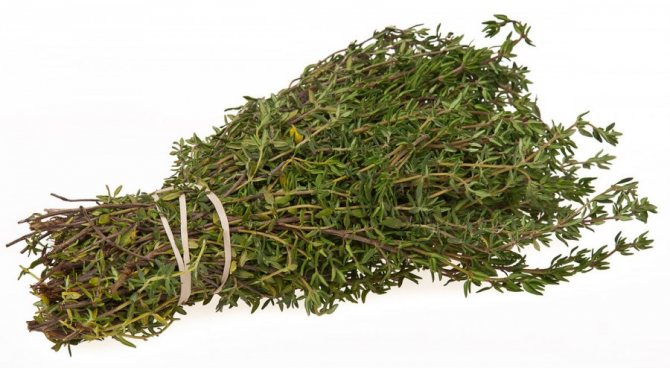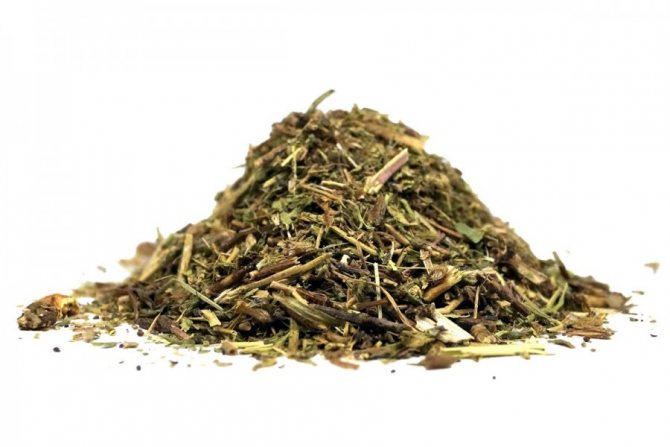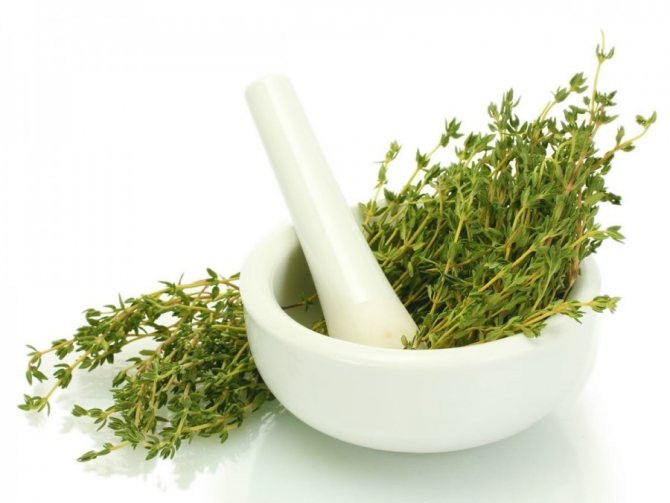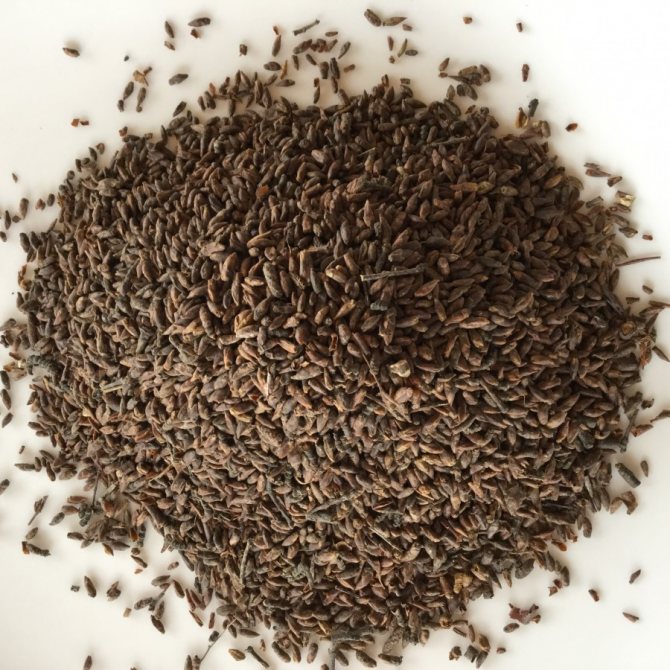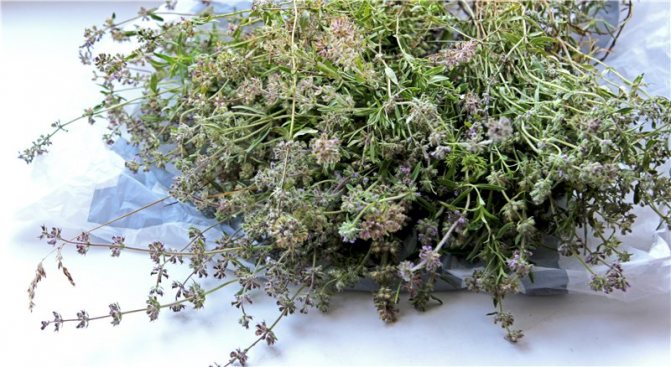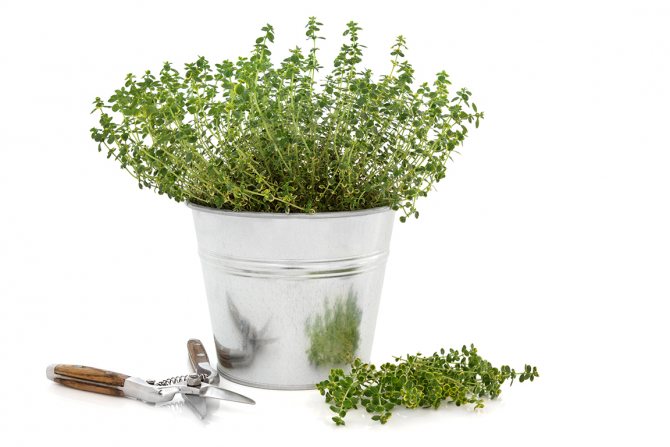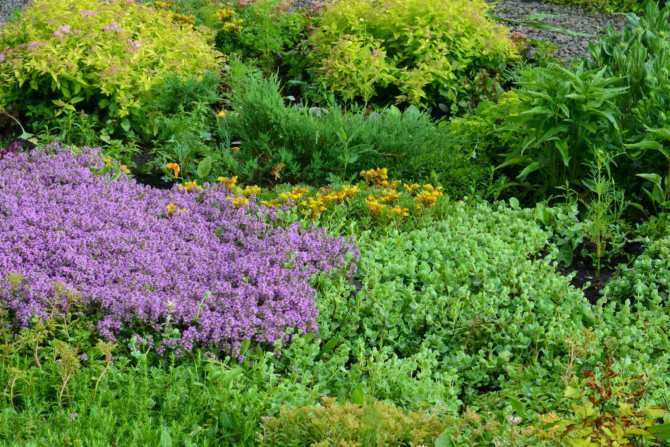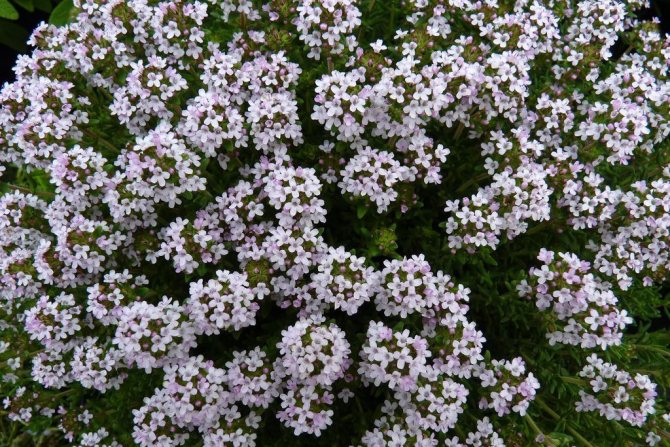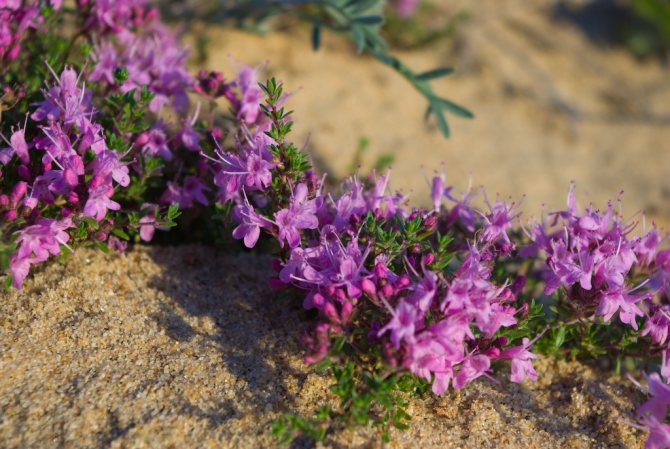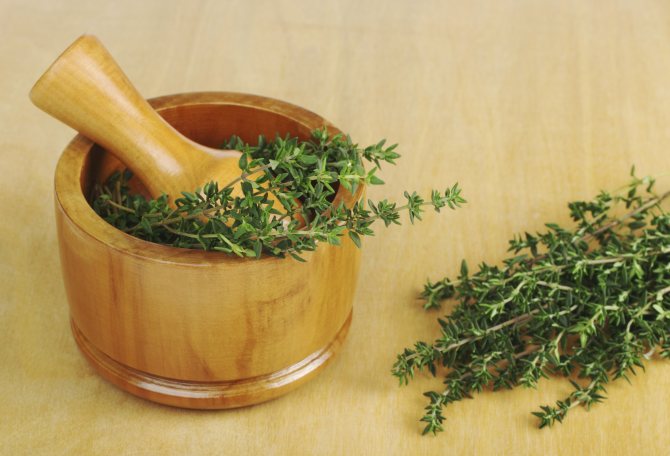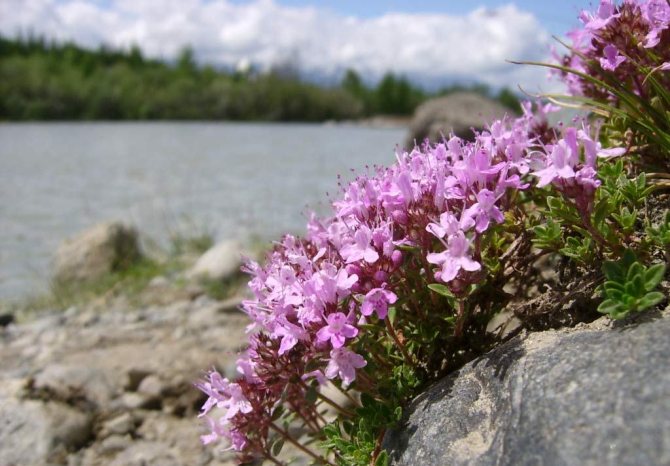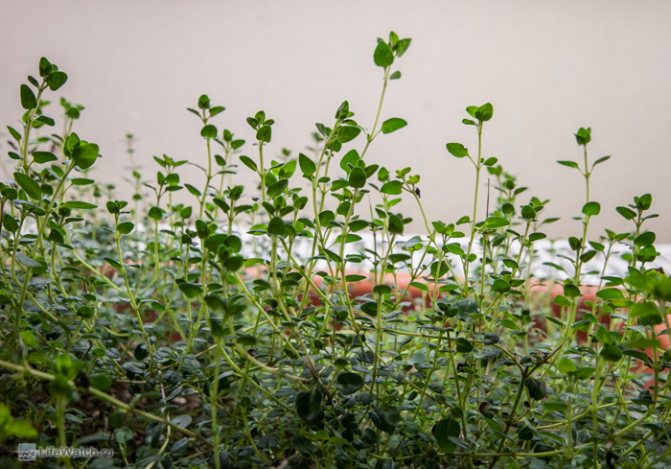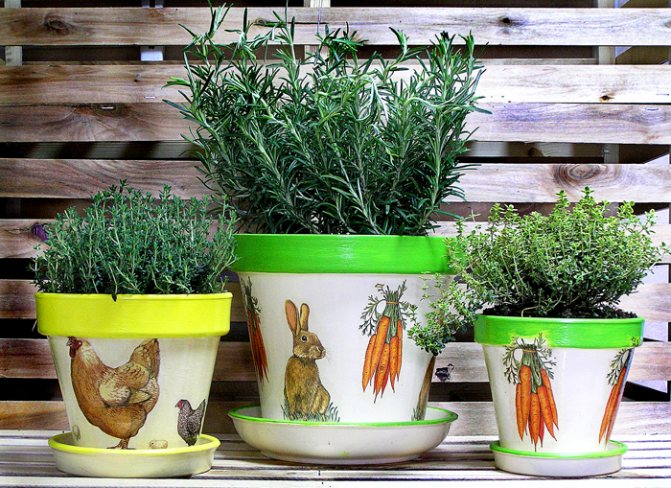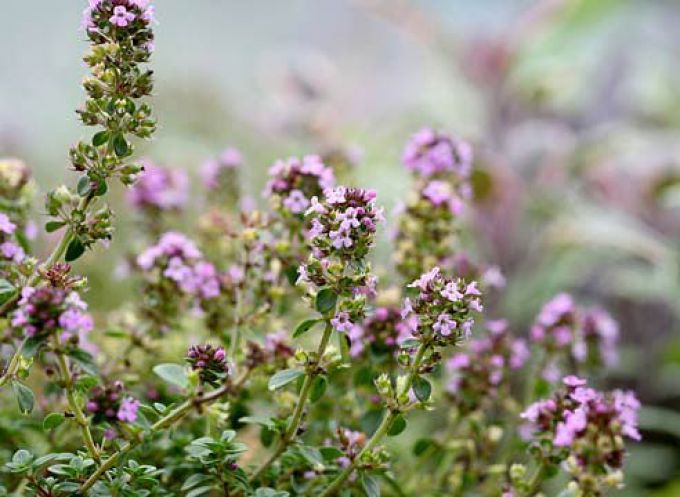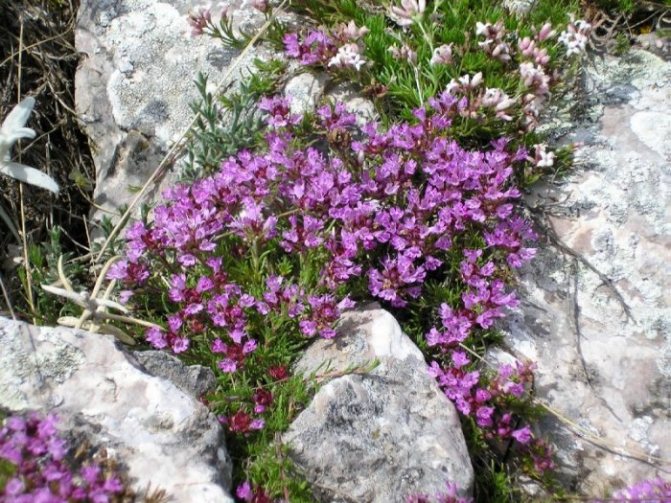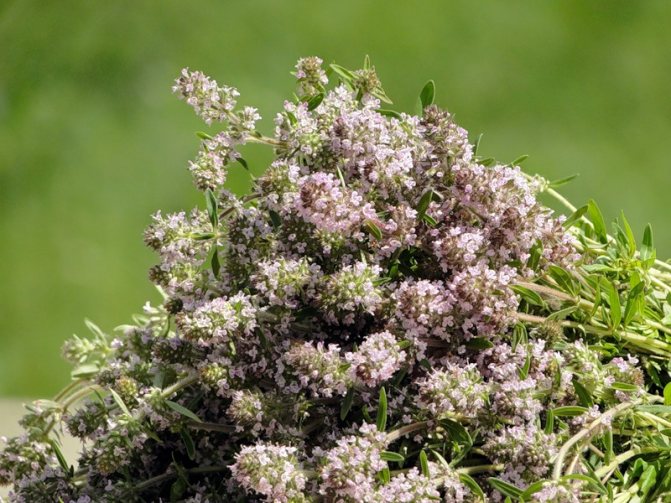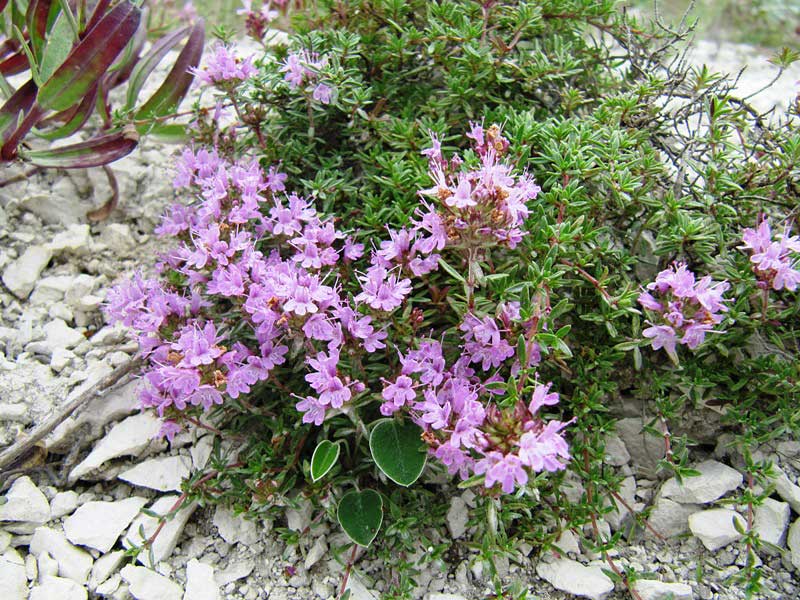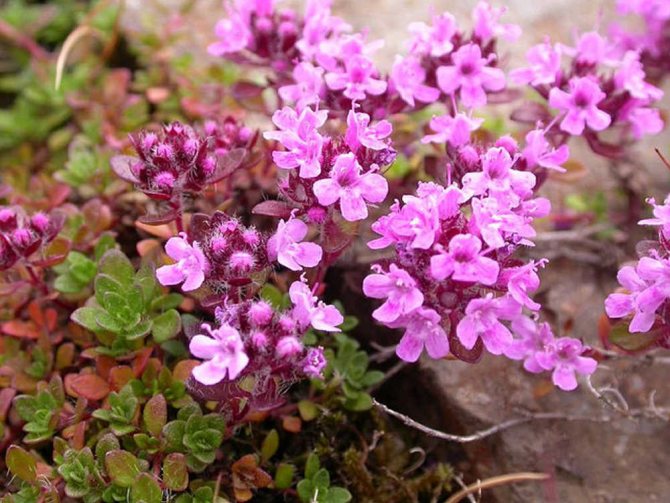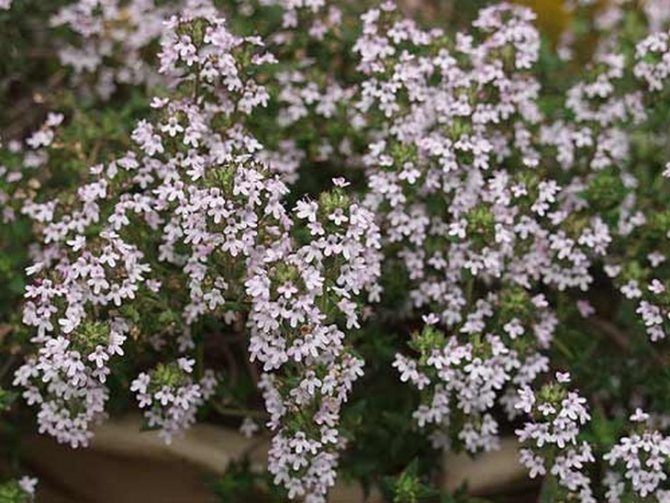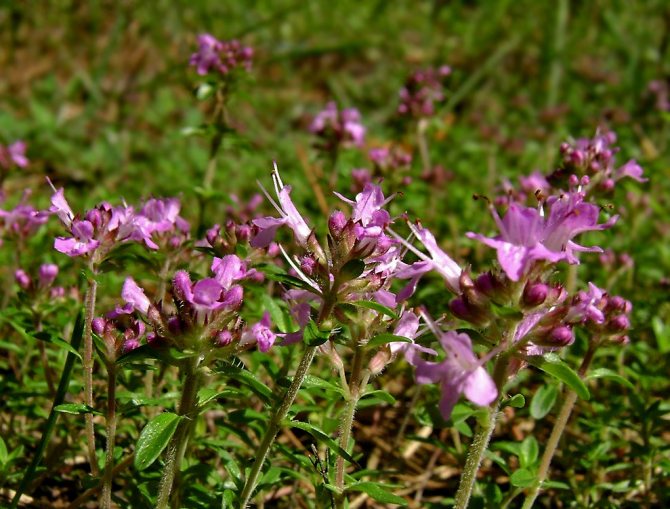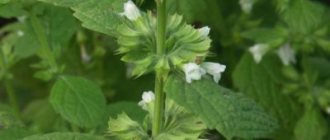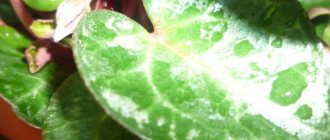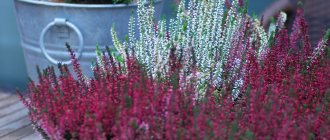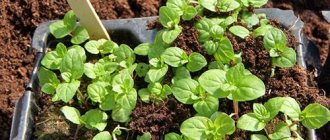
Thyme is widely used in culinary, medical and cosmetic practice. Due to its aroma, unusual taste and useful properties, the plant is rapidly gaining popularity among housewives.
To grow thyme at home, you need to properly plant it, provide the necessary illumination, optimal temperature and humidity.
Why is thyme so popular?
Thyme is appreciated not only for its beautiful appearance and aroma, but also for excellent medicinal properties... Thyme is used:
In folk medicine... A pleasantly smelling, rich thyme tea, rich in useful vitamins, active substances, is able to calm the nervous system, eliminate pain, cope with colds and many other diseases. Decoctions, infusions, essential oil are made from its leaves and flowers. Dried thyme herb is added to the pillow to help you sleep deep and healthy. In the old days, rooms were fumigated with thyme in order to get rid of microbes and harmful organisms.
In the perfume industry... Flowers and leaves are processed, and essential oils are added to creams, perfumes, eau de toilette, and soap.
In cooking... The leaves of this plant are added to food as a seasoning to give it a special taste and unique aroma. Both meat and fish dishes are seasoned with thyme. It is added to baked goods as a spice.
Thyme in landscape design... Sometimes thyme is also used to decorate a plot in the country.
Thyme is believed to be a wild plant native to the southern regions. But for a long time, amateur gardeners have been cultivating thyme in those corners where the summer is not so hot and long. The plant has adapted quite easily to different climates and feels great.
Benefits of thyme and its uses
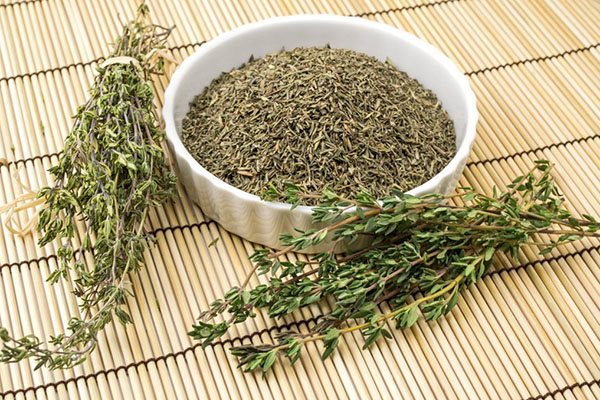

Thyme is often called the herb of shamans and sorcerers. The ancient Slavs revered thyme as a divine plant. It was used in pagan rituals, burning at the stake in order to attract the grace of the gods. They fumigated cowsheds and stalls, pots for milk, and even frightened children to drive away evil spirits.
Thyme is an amazing plant with a pleasant taste and many properties that are beneficial to the human body. In addition, this herb has some decorative effect, which is an additional plus to its cultivation in an apartment.
You can use thyme at home in the following cases:
When using thyme for cooking, it should be added in moderation due to the herb's strong natural flavor.
Thyme: what species are popular?
Despite the fact that there are more than 300 species of this plant, only four are grown in the garden plots. Their medicinal and decorative properties are most pronounced:
Marshall thyme... It is used as a remedy for eye diseases.
Creeping thyme... Planting and grooming will later come in handy for treating colds and coughs, for stomach pain, and for improving digestion.
Thyme ordinary... This species has been specially cultivated. It is used to treat colds, colds, gastritis, pancreatitis. Thyme tea is an excellent antiseptic.This type of thyme is planted in flower beds to decorate the site.
Lemon thyme... The leaves are greenish-yellow in color, the plant has a pleasant lemon scent.
Feel free to choose any of them!
Harvesting thyme
If you want to dry herbs for future use in order to add it to spice mixtures or leave it just in case for decoctions, collect it at Trinity. On this day, it is considered the most saturated with useful substances.
Only flowering plants can be taken. The leafy stems are cut with a sharp knife. Breaking off the branches, you cause irreparable damage to the entire bush.
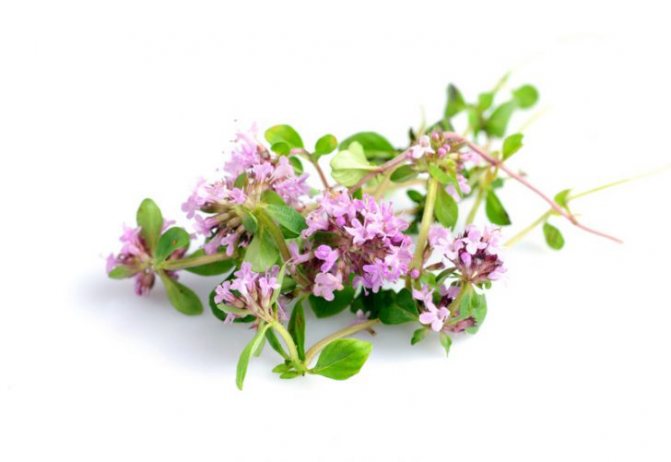

Thyme is harvested during flowering
Thyme should be dried according to general rules, spreading it out on sackcloth or gauze and leaving it in the shade. You can dry the grass in bunches by hanging bouquets in the attic.
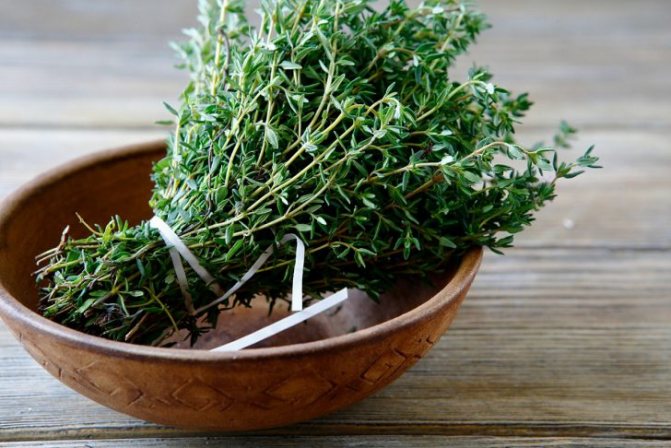

Dried thyme in bunches in the shade
Growing thyme in the open field in the Moscow region
Have you decided to have thyme? Planting and maintenance will not take long, and the plant will easily adapt to any weather conditions and will feel pretty good. Nevertheless, in order for the plant to decorate the site and please the eye for many years, bloom profusely, be healthy and suitable as a seasoning and a first-aid kit in the garden, you need to take care of it, water it in a timely manner, and weed it.
How is thyme grown?
To grow thyme outdoors no extra effort is required and no special knowledge is required. Thyme perfectly tolerates the conditions of non-dry summers and snowy winters. For its rapid growth and development, abundant flowering, a lot of moisture is required, so the climate of the Moscow region creates the best conditions for it.
Thyme was bred from wild varieties, grows well on any soil, except for acidic clay rocks. This plant is not afraid of strong frosts.
Thyme will be healthy and grow quickly if planted in warm sunny places garden plot. So that the stems do not become waterlogged and rot during the off-season, the soil next to the stem is covered with drainage from small pebbles or gravel.
Thyme looks good as an element of decorative finishing of garden paths. Planted along the edges of the path, it gives it a well-groomed appearance. This plant is also suitable for rose gardens and alpine slides, will serve as an excellent decoration for a decorative pond. And if you plant it next to the house, you can not only get aesthetic pleasure, watching its intricate inflorescences, but also inhale the aroma of flowers both in the early morning and late in the evening. You can enhance the decorative effect by planting various types of thyme on the flower beds.
How does this plant reproduce?
Thyme can be grown in three ways:
Planting seeds.
- Thyme seeds are planted in early spring. This plant can be planted in late autumn. In this case, planting is done before the onset of frost to prevent the death of seeds from frost. The soil must first be prepared: dig up and loosen well, remove weeds and roots of other plants. Then add compost. Instead, you can add rotted manure and mineral fertilizers, urea, mix everything with the ground.
- The seeds can now be sown. After planting, the seeds are covered with soil, watered, and the surface of the flower bed is additionally sprinkled with coarse sand on top. This prevents stagnation of water where seedlings will appear.
- When the plants grow a little, the planting needs to be thinned out a little so that the seedlings are stronger, healthier and more viable.
Planting seedlings... Thyme seedlings can be planted in open ground. For this, the seeds are sown in a special container, covered with a film. Wait until they germinate and seedlings appear. After about a month, the grown plants are transferred to the open air so that they adapt and harden.If after 14 days the plants continue their active growth, look healthy and well-groomed, they are transplanted into open ground to a permanent place, after digging up the soil and enriching it with fertilizers and microelements.
Planting plants with a developed rhizome... Thyme can be purchased at the market or in the shop from hobby gardeners. It should be borne in mind that when buying a rhizome with an open root system, they pay attention to the roots, stems and leaves. Only healthy plants should be purchased. In case of doubt, it is better to immediately abandon the purchase. The root must be well developed. But, even a weak root system can be improved when the roots begin to grow, and new roots appear from the stem of the plant. The main thing is that they do not have rot and pests.
The plant should be healthy, with a strong stem and dense, shiny and elastic leaves. You do not need to purchase a slightly wilted plant. It can go away over time, or it can dry out completely.
Planting a closed-rooted thyme purchased from a dedicated location is straightforward. The plant must be carefully removed from the container, inspected for rot, if necessary, cleaned, straightened and planted in prepared soil. Drizzle and sprinkle with drainage around the stems.
How to choose a landing site?
It is best to plant thyme on the south side of the summer cottage, where an abundance of sunlight will be provided.
If you plant a plant in the shadow, its bush will look loose, the leaves will be small, the stems will be extended. It will be more difficult for him to accumulate the necessary concentration of nutrients and essential oils. A pleasant aroma is out of the question. The plant will simply not be able to emit a strong odor.
Thyme growing on the warm sunny side takes the form of a small dense bush. If its leaves and branches are periodically cut off, it will expand even more in width. With proper care, by the fall, Bogorodskaya grass can acquire the shape of a ball. This plant will look especially good on a flower bed and will decorate any flower garden.
Collection and storage
Thyme herb is cut for human consumption and medicinal use twice during the growing season. In June, flowering plants contain the maximum amount of flavoring and medicinal substances, at this time harvesting is especially valuable. Secondary cutting of green mass is appointed at the end of August.
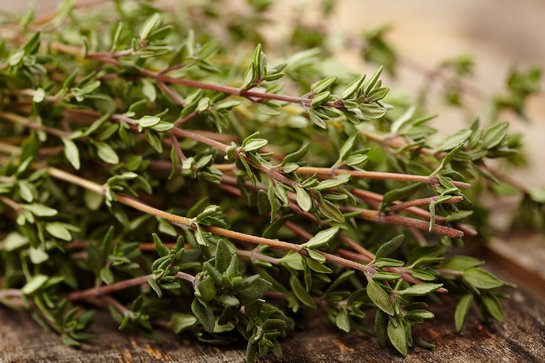

The days of collecting herbs that fall on church holidays are especially revered: Trinity and the Dormition of the Virgin. There is a popular belief among the people that in these blanks the positive properties increase many times over.
Thyme's weak, shallow root system does not tolerate hand picking. Cutting is the only correct method of harvesting aromatic herbs.
Dry raw materials should be tied in bundles, suspended in a dry place, protected from direct sunlight. A small amount of thyme can be dried by spreading it in a thin layer on paper sheets at home or indoors, sheltered from the sun and rain. An indispensable condition: the organization of ventilation.
For storage, the thyme is laid in a crushed or grated form, while the stems are removed. Ready to use, the powder is poured into hermetically sealed containers, such as a coffee can. Cookware should be placed in a dark place, such as a kitchen cabinet. Thick paper bags and canvas bags are suitable for dried herbs, but they lose the aroma of essential oils. The properties of the plant are preserved for two years.
The cultivation of thyme is justified in several cases: for use in cooking, decoration and aromatization of the garden, for medicinal purposes. The unpretentious culture is capable of growing in harsh conditions that are not suitable for other plants.It is not difficult to grow thyme due to its resistance to changing weather conditions, high survival rate. With proper care, the plant grows rapidly and pleases with abundant and long flowering.
Bogorodskaya grass care
Thyme care is completely easy:
- Watering. The plant can do without watering for a long time. But in a dry summer, you still have to water it.
- Top dressing. In the spring, the soil is fertilized with a solution of cow dung. He also needs ash, which is added to the soil, after having mixed it with the ground.
- Rejuvenation. To make the bush look better, earth is dug out of its shoots. Shoots are placed in pits and sprinkled with fresh, enriched soil. For greater reliability, you can press them with special brackets. Over time, new roots are formed, and regrown plants can be planted in other areas.
Thyme is pruned during flowering. At this time, the concentration of essential oils in its leaves and flowers is highest. After pruning, the plants are covered with loose soil and watered.
Cut stems, flowers and leaves are dried in the shade, then packaged in canvas bags.
Gardeners have long liked the low, ground cover grass spreading like a flowering carpet and exuding a unique aroma. Growing thyme, however, is not limited to a desire for landscaping. This plant, commonly called thyme, has long attracted attention for its healing properties and the ability to give a fragrant hue to meat dishes, soups, salads, marinades. In ancient Egypt, thyme was used in ritual ceremonies.
Can you grow thyme in a pot?
Many are interested in whether it is possible to grow spices at home. Thyme is great for growing in an apartment, as it is not too whimsical and does not require special care. Therefore, even inexperienced people who have never grown thyme can cope with planting and growing spices.
For disembarkation, it is enough just to pick up a suitable container for the spice, plant it and place it in a well-lit room. When growing a plant in an apartment, you will have to periodically water it so that the soil does not dry out, and feed it with fertilizers.
The main types of thyme
Among the huge number of thyme species, the following stand out:
- Ordinary. He came to us from southern France and Spain. Differs in small, lanceolate leaves of dark green color and delicate purple flowers.
- Creeping. Mediterranean look with leathery leaves of various colors. Lilac flowers have a beautiful pink hue. This thyme is frost and drought resistant and is considered an excellent honey plant.
- Lemon-smelling. This hybrid species from southern France is named so because of its tart lemon scent. The yellow leaves turn green over time. Nice pink flowers. Poorly tolerates frost, requires shelter for the cold season and regular pruning.
- Vegetable Medoc. Strongly leafy, perennial hybrid resistant to drought, cold weather, produces high yields. Excellent honey plant and garden decoration. Used fresh and dried, in cooking and traditional medicine.
Thyme from cuttings
"In a situation where the decision to breed thyme on the window came spontaneously and there were no pots or soil mixture in the house at time X, green cuttings can be left to root in glasses, either made of dark glass or specially darkened."
If you are not ready for the lengthy process of growing thyme from seed, you can try to dilute it in an accelerated way. To have fresh spicy herb, you need to stock up on pots, empty the windowsill, and buy fresh thyme herbs from the supermarket. Then follow the instructions
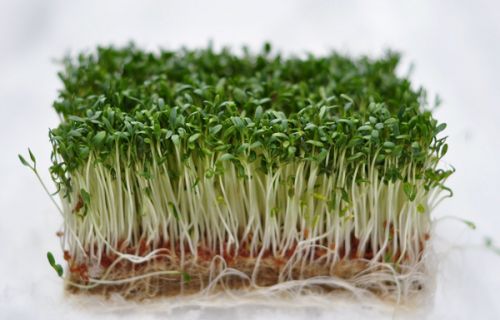

Thyme sprouts
Having brought a package of thyme twigs, carefully unpack it and select the best preserved twigs from the total mass. Make an oblique cut on the stems. This requires a sharpened knife.Tear off the leaves located below and lower the prepared cutting into the water, leaving it there for the next five or even six hours. It is very good if you use melt water warmed to room temperature. The addition of honey (half a teaspoon will be enough for half a liter of water) or such a drug as Epin-Extra (calculation of 2 drops per glass) can contribute to better rooting.
Preparing thyme cuttings
Prepare the pots while the cuttings are settling in water. They need to be scalded with boiling water and covered with expanded clay bottom. A layer of fertile soil is poured onto the drainage. It should take up about a third of the volume. The rest of the place will be occupied by calcined sand from a series of coarse-grained. All this is poured with a pink solution of potassium permanganate.
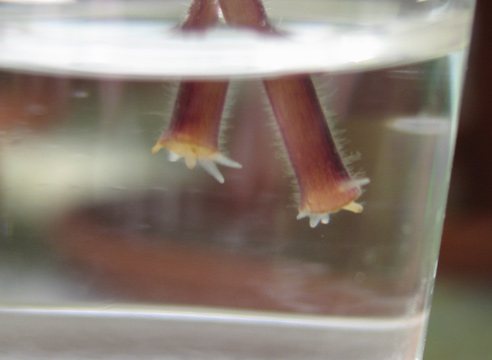

Rooting thyme cuttings
4 cuttings are planted in one pot. After planting, they are sprayed with water and greenhouse conditions are arranged for them. The pot is covered with a half-liter jar, which you will need to remember to regularly raise, giving air access to the shoots. The roots of cuttings form around the second or third week. During this period, banks are also removed. After a crescent from this moment, the seedlings can be planted in separate containers with standard fertile soil.


After rooting, the thyme can be planted
In a situation where the decision to breed thyme on the window came spontaneously and there were no pots or soil mixture in the house at time X, green cuttings can be left to root in glasses, either made of dark glass or specially darkened. Water at room temperature is saturated with an activated carbon tablet and several hydrogel granules. Provided that the microclimate of the windowsill is dry and warm, the glass is placed in a plastic bag and, filling the latter with air, tied. Roots with such germination will appear before 20 days. Transplant the seedlings into pots filled with light, fertile soil, being careful not to shave off the swollen hydrogel beads from the roots.
The roots of thyme cuttings appear within 20 days
Watering
Water the thyme in moderation, only when the soil is well dried. Only young shoots are not planted on dry rations.
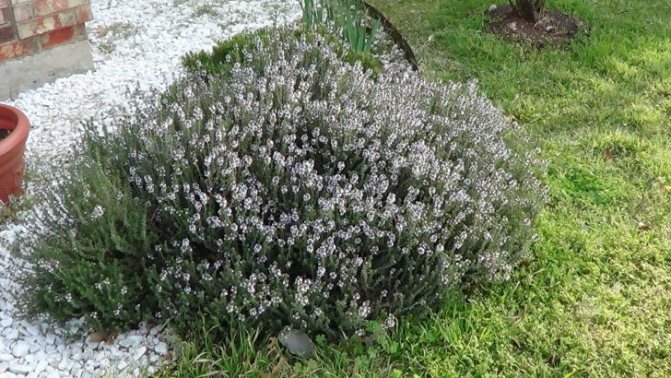

Thyme prefers moderate watering
Thyme bushes are planted in the second year, when new growth begins to grow from the root. The plant, like all herbs and spices, gratefully responds to mineral supplements.
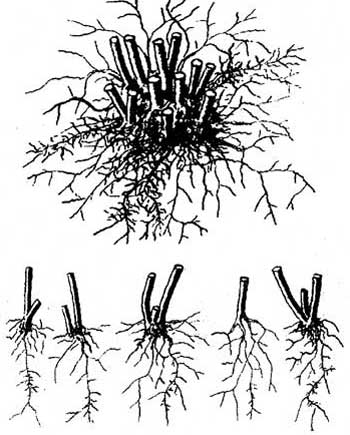

Dividing the thyme bush
Thyme in winter
During this period, it is advisable to remove the thyme from the windowsill and send it, for example, to the glazed balcony, providing the plant with a rest period. The balcony can become his shelter only if there are no too low temperatures on it in frosts. Readings below +5 are cause for concern and the transfer of thyme to another, warmer place


In winter, the thyme bush can be transferred to the balcony
Continuous distillation of thyme is also practiced, but in this case it needs to be provided not only with a warm windowsill, but also with additional lighting.
Growing methods in the country
Growing thyme in your garden is easy. To do this, prepare seeds, cuttings or divide a bush. It is necessary to take into account the active reproduction by self-seeding, as a result of which, over time, it will be necessary to deal with the limitation of space.
Seed thyme
Sowing seed is possible on a site thoroughly cleared of weeds. Since small seeds hatch within a month and develop very slowly, weeds interfere with the process. Therefore, it is preferable to grow thyme by seedling method. For this, at the beginning of spring, a soil mixture of sand and peat is prepared, which is poured into boxes, trays or containers. The sown seeds are kept under polyethylene or glass until sprouts appear. Seedlings require regular, moderate watering and good lighting.After 3-4 weeks, plants that look strong are hardened in the open air for two weeks, after which they are planted in a permanent place of growth.
Thyme from cuttings
In summer, green cuttings are used for propagation of thyme. This method is distinguished by successful rooting. The procedure is carried out before flowering. The tops of the stems should be cut off to a height of 10 cm, placed in river sand and covered with a piece of polyethylene. A month later, rooted specimens are planted in open ground.
When dividing the bush, the base is broken and the roots are carefully untangled.
It is recommended to cover the plots with a glass jar for a week in order to increase the survival rate.
Planting thyme
Growing a hardy and unpretentious shrub will not cause trouble for the gardener. Bogorodskaya grass adapts to the proposed climatic conditions and, with a competent attitude, responds by forming a spherical bush and building up a useful mass.
Site and soil selection
To plant thyme, you need to choose a place in the garden that is open to the sun's rays, but without drafts. The soil must be neutral and well-drained. Heavy, clayey and highly moist soils require sanding. In order for the grass to feel good in the open field, acidification should not be allowed, for which chalk or lime is added.
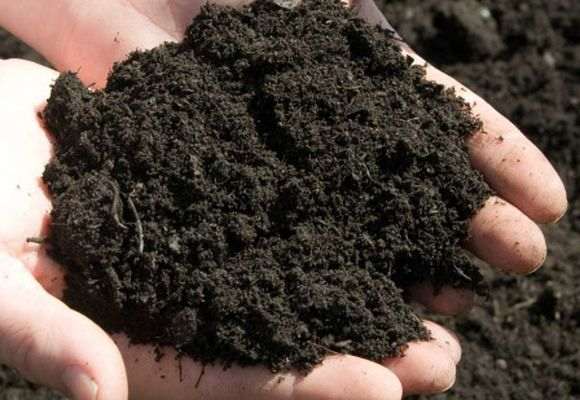

It is necessary to take into account the general design in the garden so that the luxurious plexus of thyme harmoniously fits into the landscape.
When and how to plant thyme?
Planting of thyme seeds is carried out in autumn and spring after aging in warm water for 12 hours. Seedlings are thinned out, maintaining an interval of 30 cm.
Seedlings are best planted at the end of the frost, on a warm, sunny day. A spacious hole is being set up. The seedling is removed from the container and placed in a mixture of earth and sand. The soil surface is compacted, after which the plant is watered. When propagating by cuttings, planting is carried out in August.
When planting thyme in open ground with seeds, the flowering of the shrub will occur in the second year of life.
BOGORODSKAYA GRASS
Thyme has many names. Most often they use the word "thyme" or the poetic name "Bogorodskaya grass". The word "thyme" in Greek means "strength." With this name, the ancients wanted to emphasize the extraordinary medicinal power of thyme.
Today, the smell of thyme among the inhabitants of our latitudes is primarily associated with the Crimea and the resorts of the Transcaucasus. In Asia, the taste of thyme is a must in national lamb dishes. Also, this spice is an indispensable ingredient in French cuisine.
Thyme is a genus of plants family of Labiaceae (Lamiaceae)
... The genus Thyme is numerous, including more than 350 species. Over 170 species of thyme can be found in Eastern Europe. Not all types of this plant are suitable as a seasoning, since they differ greatly in the color of the leaves and the smell. Bogorodskaya grass is called creeping thyme. Naturally, this thyme grows on dry slopes. Therefore, when growing on a personal backyard, it is necessary to allocate sunny, well-lit areas for it all day. In the shade and even in partial shade, varieties with an unusual leaf color lose this feature.
RARE PLANT SEEDS FOR YOUR GARDEN - FREE SHIPPING. PRICES ARE VERY LOW. THERE ARE REVIEWS


Outwardly, this plant looks like a compact shrub or semi-shrub up to 40 cm high (most often 15-20 cm). Thyme stems are lignified, leafless, lying or ascending. Herbaceous branches with small pointed leaves rise from the stems. The flowering branches are erect. It is a perennial plant.
Thyme blooms from May to August. Its flowers are lilac, pink, there are varieties with white flowers.
Summer residents often use thyme as an ornamental plant. With its help, the irregularities of the site are decorated. He is a permanent inhabitant of the now popular aromatic gardens.
Thyme fruits are small, oval, smooth nuts of black or black-brown color. Thyme tastes slightly bitter and spicy, and its smell is pleasant and persistent. Collect sprigs of thyme with leaves and dry, then chop. With this preparation and proper storage, the seasoning does not lose its aroma for up to two years.
This plant readily grows in open ground, as well as on a windowsill.
Thyme is a very good honey plant and is indispensable in the area where there is an apiary. Also, when planting several bushes near or in the greenhouses and greenhouses themselves, it attracts pollinating insects there.
Description of the plant
In Latin, thyme sounds like Thymus vulgaris. The people gave him several names, including Bogorodskaya grass, Savory, Fimiamnik.
This plant grows throughout Russia. His most favorite place is the sunny foothills of the Caucasus. Thyme prefers open meadows and glades.
Thyme is a fragrant low shrub growing up to a maximum of 30 cm. It has a thin stem, woody at the base and creeping. Its leaves are small, oval with white villi around the edges.
The two-lipped flowers of thyme are pink or purple in color. The fragrant bloom occurs between June and August.
THYME: BENEFITS
This spice is rich in flavonoids, organic acids and mineral salts. Since ancient times, people have collected wild thyme for medicinal purposes. They are harvested even now, but we must remember that the plant cannot be pulled out by the roots: thyme has a very slow growth!
Thyme is very valuable as a medicinal plant. A decoction or infusion of its greens (15-20 g per 1 glass of boiling water) helps to defeat colds and flu, is also used to improve digestion, as a diaphoretic, sedative, pain reliever, for insomnia, headaches. Thickened decoction of thyme in sunflower oil is used as compresses for the treatment of arthritis and radiculitis. Rinse the mouth with thyme tincture for inflammation and ulcers.
Seed thyme
To grow a spicy plant at home, there is absolutely no need to spend money on the purchase of seedlings, which, by the way, will still have to be searched thoroughly. It is much easier to use seeds for this. Thyme planted in a pot will grow normally on a sunny balcony, as well as on a windowsill, provided a regular ventilation regime is provided.
Thyme seeds
The shrub has a small root system, making it an ideal spice for home growing. Thyme on the window will also be aesthetically pleasing. Its flowers will delight the eye, and its sophisticated aroma will delight the sense of smell.
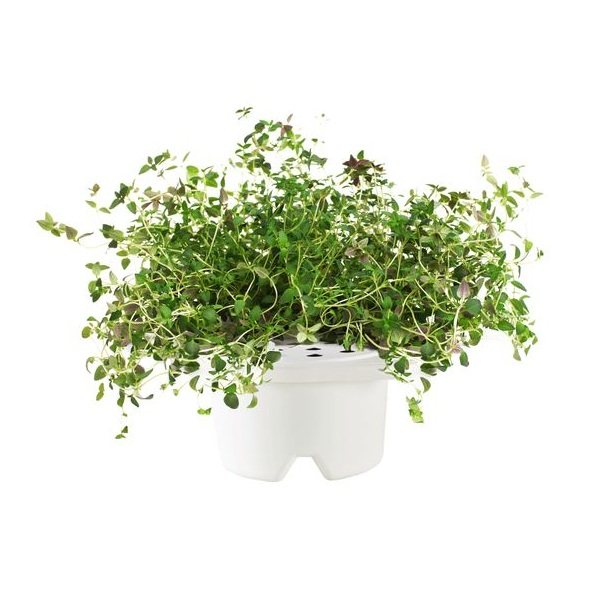

Thyme is ideal for growing on a windowsill
Action plan:
1. Prepare a small pot, 15 centimeters deep.
2. Cover the bottom with drainage. A two-centimeter layer is enough.
3. Prepare the soil. We mix it with vermiculite.
4. Moisten the soil from the spray bottle and place it over the drainage.
5. Shade the pot until the first growth appears. This will help the sprouts to grow stronger and not burn out in the sun.
Thyme seed germination is excellent, so you can leave the strongest sprouts for divorce, and remove the rest.


Thyme is ideal for growing at home
LOOKING FOR A PLACE FOR THYME
Light, non-acidic soils are suitable for growing thyme. The reaction of the soil should be slightly alkaline, close to neutral. The soil should be well-drained, loose and breathable.
Like most spicy-flavoring plants, thyme is picky about light and is not afraid of direct sunlight. It is grown in an open, sunny place.
Thyme is a cold-resistant plant. But he does not like drafts and northern winds. Therefore, it is necessary to grow thyme in an area protected from strong winds. You can place a mini thyme plantation behind berry bushes.
Top dressing is primarily organic fertilizers.But if manure is used, this organic matter is introduced only in the fall, for digging. Humus is added to the soil intended for thyme in the spring, just before planting.
Thyme does not tolerate being "poured" and does not like stagnation of moisture at the roots. This drought-resistant plant does not need abundant watering. Requires watering only during dry periods,
Diseases and pests
The aromatic substances secreted by thyme in large quantities serve as a good protection against pests. Violation of the rules of care can provoke an attack of insects.
Significant damage to the plant is caused by:
- Meadow moths affecting stems and leaves. Activated on warm nights. Treatment with insecticides helps.
- Sandy slugs completely destroy aerial organs. They fight them with poisoned baits.
- Weevils. They feed on young shoots, flower buds. Planting can be secured by treating with insecticides or installing baits with poisonous preparations.
- Aphids attack the stems and leaves of thyme. Does not tolerate insecticides.
See also
Description of varieties and varieties of black thyme (thyme) Read
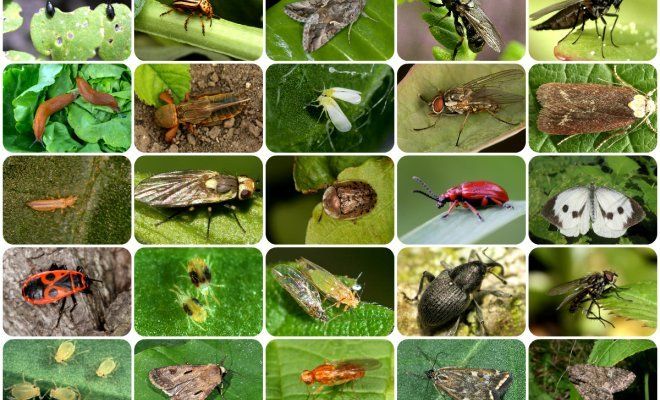

Preventive measures to protect against pests and parasites are: regular loosening, timely removal of weeds, deep digging and the introduction of alkaline fertilizers.
GROWING CONDITIONS
Thyme is propagated by seeds, seedlings and cuttings.
Seeds can be sown even in our latitudes directly into open ground or in a greenhouse. Crops are placed at a distance of 15-20 cm from each other, with row spacing of about 35 cm.The seeds are planted to a depth of 0.5 cm.
Seeds are sown for seedlings in March, and in early spring the seedlings are planted in the ground. The seeds are not soaked before sowing. Dry buried in the soil to a depth of about a centimeter. When planting seedlings, it is taken into account that the distance between the rows should be at least 45 cm. You can propagate thyme by dividing the bushes (it is better to do this in spring).
Thyme requires careful maintenance. Be prepared to regularly loosen the soil between the rows and directly around the bushes. Water on dry days, weed constantly. Weed control is especially important during the period of active collection of greens for harvesting.
Thyme does not develop very actively at first. In the first year, constant careful weeding and loosening are needed, as well as periodic moderate watering. Top dressing is not done in the first year. In the second or third year, humus is introduced into the soil, as well as complex mineral fertilizers.
It is recommended to resume planting thyme after three to four years.
How to plant thyme at home?
There are several common methods for planting thyme. To cultivate spices in an apartment, use planting cuttings or seeds. To choose the most suitable landing method for yourself, you should familiarize yourself with each of them in more detail.
From seed
Most often, the spice is planted with seeds, as it is easier. To do this, a soil mixture mixed with vermiculite is poured into previously prepared containers, which improves moisture retention in the soil. Then the soil in containers is watered with warm water and holes are made in the ground. Place 2-3 seeds in each hole and cover them with earth. The planted plants are transferred to the windowsill and watered regularly. When the first shoots appear in the pots, they are thinned out for better growth.
From cuttings
Some people prefer to propagate thyme bushes using cuttings. First you need to start harvesting cuttings for planting. After the end of the flowering of the thyme, the shoots are cut off from the bush and completely cleared of leaves. Cut off often the shoot and will be a cuttings that are planted in a pot.
Planting thyme cuttings in the ground is quite simple. To do this, the pots are completely covered with soil and depressions are made in it 1-2 cm deep. Then the shoots are placed in the holes and sprinkled with earth.The planted cuttings are watered in 1-2 days before the first leaves appear on them.
TIME TO ASSEMBLY
Leaves and shoots are harvested several times during the growing season. Shoots are cut 5 cm above the ground. After that, the plants are fed.
The time for the main collection of tops, which are used in cooking as a spice, occurs at the end of June-July. Flowering shoots are used for medicinal purposes. Thyme seeds are harvested from plants two to three years old. The testes matured when the seeds turned brownish. Dried thyme in the shade, sprinkling on a clean cloth or paper, in a natural way.
Choosing a place for indoor thyme
Some inexperienced housewives pay little attention to choosing a suitable landing site, since they believe that the spice will grow in any room. However, this is not the case and therefore you should familiarize yourself with the features of choosing the best place for planting thyme.
Lighting
Thyme is considered a light-loving plant that grows best in the sun. It is recommended to place the pot with the plant on windowsills that are well lit by the sun. If the spice is planted in winter, you will have to take care of additional lighting and install special lamps.
Temperature and humidity
Thyme grows best in cool rooms with an air temperature of no higher than 20 degrees Celsius. In the fall, you can take the pot out to the glazed balcony during the day and bring it into the apartment only in the evening, after sunset. In winter, it is impossible to take out the spice to the balcony, as it will die from the low temperature.
HOW THYME WINTERS
For the winter, thyme is covered. Shelter is not necessary for all species of this winter-hardy plant, but it is better to play it safe. Like other perennial spicy plants, thyme is first covered with leaves, and on top - with cardboard in several layers (you can also use other non-woven covering material). As a "fur coat" for the winter, instead of leaves, spruce legs, sawdust and even dry peat can be used.
It is not recommended to cover plants with polyethylene for the winter. Rot and fungal pathogens are actively developing under the film.
After the snow falls, you need to sprinkle the plants with them, collecting the snow cover from the paths or lawn. "Winter" for thyme in our latitudes is equipped in November.
The March sun can burn plants. If the thyme is not covered, you should at least install a sunscreen on the south side.
Even for the most winter-hardy plants, proper preliminary preparation for winter is very important. It consists in stopping feeding with nitrogen-containing fertilizers. But adding a layer of humus and soil will improve and warm the roots in winter.
Winter shelters are removed when the snow melts. And immediately they feed with nitrogen fertilizer - a matchbox of urea for a 10-liter bucket of water.
Thyme: the smell of the steppes


I remember how in childhood, on the eve of Trinity, we brought armfuls of thyme (thyme) to the house and laid it on the floor along with other herbs. Then for several days in the house there was a spicy aroma of these marvelous plants. That was a long time ago…
And although at that time whole hills in the steppes were covered with purple thyme rugs, adults warned us that it is impossible to pull out plants with roots, you need to cut them off with scissors. And unfortunately, now our beloved steppes have become impoverished, only tiny islets of thyme remain on them. When you see these blooming curtains-pillows, you just want to touch them. And if you run your hand over the bushes, a cloud of heady aroma rises into the air.
The breeders also paid attention to thyme. Scientists have appreciated its spicy-aromatic properties, abundant and long flowering, compactness of bushes, as well as unpretentiousness to growing conditions. As a result of crosses and selection selection, new varieties of garden thyme have appeared.
They differ from species plants in a more attractive appearance, beautiful dense foliage of various shades, as well as the size and color of inflorescences. At the same time, varietal thyme retains the unpretentiousness and resistance to drought inherent in wild-growing species.
We especially like grade Golden King.
Its pale green leaves with a yellow border smell like lemon. Its variegated foliage makes it beautiful even before and after flowering. In late autumn, there are few corners in the garden untouched by the approaching cold. A golden bush of thyme as if nothing had happened - it stands in all its glory next to silvery santolina and exudes a whole bouquet of delicate aromas.
We have several varieties of Thyme growing, and each of them is good in its own way.
But there is never too much thyme. Last year, in the spring, we bought two new varieties on the market. The seller did not know what they were called. One plant was a dense pad of small leathery leaves, which, it seemed, could not be "stitched" not only by weeds, but also by a real needle.
And the other looked completely different, it was a bush in the form of a ball, similar to sheared boxwood, but with smaller leaves and a stunning aroma. Imagine our surprise when, having planted it on a hill next to other thymes, we realized that we already have exactly the same variety.
True, the old-timer looked somewhat disheveled, without shaping, and this confused us. And our newcomer, after the skillful hands of a garden “hairdresser”, has turned into an elegant bush, capable of realizing any design idea.
Thyme is appropriate on a rocky hill, in a pot, a curb, and even the crevices of garden paths.
For good growth and flowering, it needs an abundance of sun and moderately dry soil. Thyme is easy to combine with other ground cover plants. The classic compo nies of thyme are sedums. They are also children of the sun, and they have the same requirements for growing conditions. Another advantage of thyme is the absence of pests, they are not interested in this plant. Thyme is easily propagated by dividing the bush. But it is better to divide it into large parts with a lump of earth, and not into separate shoots with roots, then the bush grows quickly. In early summer, you can cut off annual semi-lignified cuttings and root them. Propagated by thyme and seeds, sown before winter or early spring.
Seedlings grow slowly, bloom in the second year. To speed up the growth of the bushes, layering is made, pinning and sprinkling the side shoots with earth. Weeds do not grow under the thyme pillow. A thick thyme rug looks very decorative.
Blooming thyme is a wonderful honey plant and, which is very valuable, a kind of health-improving agent for bees. Thyme is widely used in cooking. It is a part of Mediterranean cuisine, is suitable for meat, vegetables and fish, it goes especially well with tarragon. It is also used for the preparation of pickles and pickles. And fragrant tea with thyme will not only calm the nervous system, but will certainly remind you of summer. The healing properties of this plant are widely known.
Thyme is the basis of pectusin, a cough medicine familiar to everyone since childhood. Thyme is harvested during the flowering period, it is at this time that the plant contains the largest amount of essential oils. It blooms so abundantly that even if you cut off some of the flowers, the bush still retains its decorative appearance.
Be sure to plant thyme on your plot, because it requires so little, and gives so much.
Thyme on the windowsill - how to plant and how to grow
In this article, you will learn:
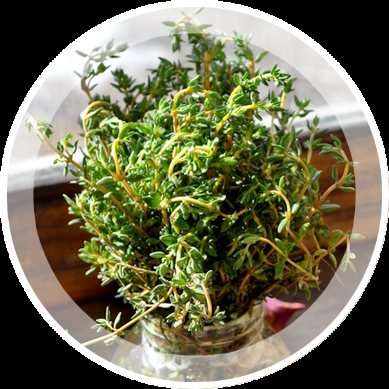

Thyme
[2], also thyme and thyme (lat.
Thymus
, from other -grech. Θύμος or Θύμον) is a genus of the Lamb family (
Lamiaceae
), one of the largest and taxonomically complex genera of this family.
The beneficial properties of thyme
For those who love this amazing-smelling spice, growing it at home is a godsend! Moreover, this is a very undersized and compact bush that will not take you much space or much time to leave.
But on your table there will always be the famous Provencal spice, which you will use at your discretion - both in dishes, and in cough tea, and in cosmetic personal care.
Sleeping on a pillow full of thyme herb is believed to bring health and longevity.
How can you use thyme?
- For colds, bronchitis, acute respiratory infections, thyme baths are very useful. The essential oils contained in this spice will be absorbed into the body through the pores of the skin, healing it, first of all, the respiratory tract will heal.
- Thyme is capable of relieving spasms, killing germs, and treating coughs. To do this, brew it and drink it like tea.
- The extract of this herb is a part of the medicine "Pectussin", which is successfully used for colds and inflammatory diseases of the upper respiratory tract.
- Thyme compresses and baths are excellent for pain when joints are affected and there are diseases such as sciatica, arthritis, arthrosis, etc.
- When preparing food, keep in mind that thyme is ideal in meat dishes, especially fatty ones, it is remarkably "adjacent" to cheeses and cottage cheese, with poultry and game. Perfectly emphasizes the taste of all dishes where there are legumes of all kinds.
- Use it in smoked foods, in marinades, add when baking homemade flavored bread.
- When kneading pizza dough, be sure to add some thyme to it, and your pizza will be truly Italian!
- Just use this flavorful seasoning in very moderation, it's pretty strong.
Growing in a pot, this spicy herb thrives on a sunny windowsill or loggia, where there is good ventilation.
It has a small root system, so it does not require large pots.
The thyme blooms very beautifully! So it is also a decorative decoration for your home, pleasing to the eye.
In general, the perfect spice in every sense!
How to grow greens on a windowsill- video
How to grow thyme on a windowsill?
thyme on the windowsill photo
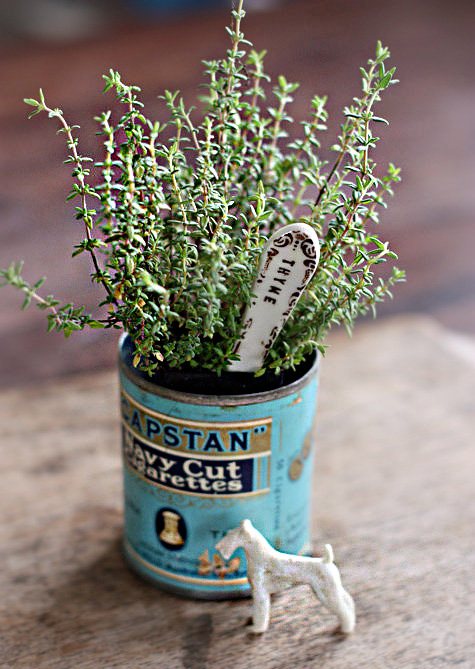

There are two ways to grow thyme: seed method and plant cuttings.
How to grow from seeds?
The action plan is as follows:
- Take a small pot, about 15 centimeters high.
- Lay the drainage on the bottom with a layer of 2-3 centimeters.
- Mix the soil with perlite or vermiculite. But this is optional, it is possible without them, and it will be fine too.
- Moisten the soil. You can do it from a spray bottle, it's more convenient.
- Plant a few seeds.
- Pour about 1 centimeter of soil on top of the seeds, covering them completely.
- Moisten again and carefully observe that the soil is always moist before the first shoots of the plant appear.
Tip: before the first shoots appear, it is better to shade the seed pot slightly, and not keep it in open sunlight. Sometimes it happens that too strong rays of the sun ruined the seedlings. So it is better to do moderate light access, you do not need to be too zealous in this.
- Seed germination
The germination of thyme seeds is very good, the first sprouts appear after 10-20 days, and after a couple of months it will be possible to leave the strongest shoots, and the weaker ones can be transplanted into other pots or distributed to friends and acquaintances.
How to grow from cuttings?
This method is also used quite often. This is usually done in the fall.
The action plan is as follows:
- After the flowering period has passed, cut off the shoots with a sharp knife or scissors as much as you need.
- Free the lower part of the cutting completely from the leaves.
- Pour drainage into the pot, then soil. Moisturize.
- Plant the cutting in a well-moistened soil, sprinkle with earth.
- Watering should be done every other day until the first new leaves appear. Then - as needed, avoiding severe waterlogging so that the plant does not die. Remember that in the wild it grows on rocks, where it is sunny and dry.
- If you use a cutting, having dug it out already with roots, then when planting in a pot, pay attention to the fact that it (the pot) should be slightly wider than the root system, but not too large, otherwise the roots will not have time to cover the clod of earth, and the soil may acidify.
Creeping thyme (Thymus serpyllum) - benefits and harms, use and contraindications
It is better to plant in an open, sunny area.
Winters well under the snow.
Prefers neutral or alkaline soils. On heavy clay, and even with excess moisture, it can undermine.
It can be fertilized with compost, bone meal, but in general it is not particularly picky about fertilizers.
After flowering, the bushes are pruned by two-thirds.
Watering at the root is necessary in the heat, then lush flowering is guaranteed.
It reproduces well by dividing the bush during the entire growing season.
Thyme contraindications
Allergies, liver and kidney diseases, pregnancy, stomach and duodenal ulcers in the acute stage, thyrotoxicosis, atherosclerosis of the vessels of the heart and brain.
In large quantities, thyme irritates the stomach lining, liver and kidneys.
Uses of thyme
Herbal tea with a wet cough (promotes sputum separation and reduces hoarseness): mix 1 tablespoon each. anise seeds, eucalyptus leaves, chamomile and mullein flowers, Icelandic moss, thyme herb and 2 tbsp. leaves of coltsfoot. 1 tbsp collection, pour a glass of boiling water, boil for 30 minutes. in a water bath, cool and strain by squeezing. Top up with boiled water to 200 ml, take a quarter of a glass 3 times a day for 14 days, repeat the course after a week break. If the cough is a consequence of a chronic lung disease, continue the treatment with the collection for another 14 days and then take it in case of exacerbations.
For bronchitis with a lingering wet cough, mix 1 tablespoon each. anise seeds, mullein flowers, licorice root and 1.5 tbsp. creeping thyme. 1 tbsp collection, pour a glass of boiling water. Heat and boil in a water bath for 15 minutes, cool and strain. Squeeze out the raw materials and add the infusion to the original volume with boiled water. Take a quarter glass 3 times a day between meals.
For insomnia in adults and as a soothing tea for children, prepare a collection of hawthorn fruits, cordial linden flowers, thyme herb, and rose hips (2: 2: 5: 4).
Contraindications for use
Having learned how to grow thyme on the windowsill, you need to familiarize yourself with the contraindications for using the spice.
Thyme should be used with extreme caution if:
- any heart disease exists;
- exacerbation of chronic diseases of the gastrointestinal tract;
- with renal and hepatic insufficiency;
- individual intolerance, allergic reactions to thyme.
The uniqueness of thyme is undeniable. It has been used for cooking and as a treatment for certain diseases long before our time. The ability to grow thyme on the windowsill at home is a nice additional bonus for lovers of this spice.
Agrotechnics of growing thyme: secrets and nuances of care
Thyme is a very unpretentious plant that feels great almost anywhere and does not require complex and tricky steps to care for it.
- Watering. Thyme or creeping thyme can tolerate drought well, so it is important to use a reasonable amount of water when watering these plants. In the presence of a normal amount of natural precipitation, it is not necessary to water the thyme at all. If the summer turned out to be dry, watering is extremely rare. It is necessary to increase the amount of water application at the time of vegetation and flowering.
- Loosening. This plant is especially sensitive to soil conditions, which is why it is so important to regularly loosen the settled soil around the plants. This must be done very carefully so as not to damage a large number of young shoots creeping along the ground. When loosening, remove any weeds that might interfere with the full growth of the thyme.
- Feeding thyme. Creeping thyme differs in that it practically does not need abundant feeding and grows well on moderately fertile soils.If during planting you fertilized the soil well, then in subsequent years it is enough to add urea once, and the next year you can add a little complex mineral fertilizer.
- Pruning. Thyme does not need full pruning, however, if you want to get a beautiful creeping plant to form a spectacular flower carpet, then you need to carry out a number of actions. After the end of flowering or in early spring before the start of the growing season, it is recommended to slightly shorten the plant, which will provide it with the correct shape and good density. To do this, cut off all the shoots to the woody part, about 2/3 of the branch.
- Thyme in winter. This plant is considered frost-hardy, but in the absence of sufficient snow cover, it can freeze out. Therefore, before the onset of cold weather, it is important to cover the thyme. For this, you can use fallen leaves.
Care
Thyme growing in a pot at home, like all other indoor plants, requires some care. In the process of growing, it must be watered, fed and shaped.
| Watering | Thyme is a drought tolerant plant. Therefore, it is easier for him to endure a little drying than a bay. With a properly selected irrigation regime, the topsoil should dry out slightly. On average, for a plant growing in an apartment, one watering per week is enough. |
| Top dressing | Thyme growing on the windowsill must be fed during the period of intensive growth from March to September. To do this, use universal fertilizers for indoor plants. In cases where the plant is grown for greens, only organic matter is used. For example, a humate solution. |
| Formation | To get a lush, dense bush, you need to plant several plants in a pot. They should be cut once a year. The haircut is carried out in early spring. During it, shoots that have stretched out over the winter are removed. |
When applying fertilizers, the recommended dosages should be strictly observed. If too concentrated solutions are prepared, the plant can get severe root burns.
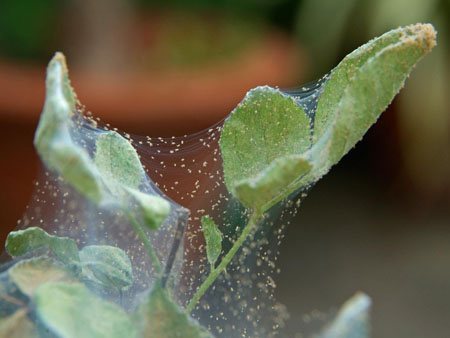

Spider mite
Growing
To grow thyme on your own, you should know that the seeds of this plant are not resistant to sunlight. Planting thyme should take place without a strong dusting of earth. The first shoots appear within a maximum of 3 weeks after a stable temperature of 20C and higher is established.
In the first shoot, several branches are formed at the shrub. They are small in size. There is no need to weed them regularly. In the next season, thyme will definitely bloom. However, you should not harvest immediately. Sprinkle earth on the shoots to help them take root.
Thyme is also grown by cuttings. To do this, you need to: cut off the shoots with scissors, free the lower part from the leaves, plant the stalk. Detailed photos of growing thyme using cuttings are available on the Internet.
Water the plant every other day until the first leaves appear. Gradually covered with earth. When the roots grow back, a plant transplant is necessary.
There is no need for deep tillage, as the rhizome is superficial. Nevertheless, the area with the plant must be thoroughly cleared of weeds.
Thyme prefers sunny sides with neutral soils. In a shaded area, the plant will grow slowly and will not have a strong scent.
Healing properties
For medicinal purposes, the collection of thyme is carried out in the first two summer months. Collect only the upper, aerial part of the shrub. Active nutrients are found in leaves and stems. Among them: essential oils, resins, mineral salts, etc.
Also, thyme is rich in various useful acids: cinchona, coffee and others. It is thanks to the various components that thyme is used for medicinal purposes. It has antipyretic and sedative properties.
Also, thyme has antibacterial, disinfectant, sedative and many other effects.
The plant has a beneficial effect on relieving fatigue and improving mood. Breathing becomes even and clean due to its disinfecting properties. Thyme preparations are used for the following diseases:
- cough;
- bronchitis;
- asthma;
- tuberculosis;
- rheumatism;
- muscle pain;
- gastritis;
- rash.
Experts also mention the benefits of thyme for the stronger sex. It has a beneficial effect on potency, improves erection and reduces the risk of developing prostatitis.
This plant is often used as a mild diuretic. It improves food digestion, bowel movements and appetite. Works great against worms. It is often prescribed for babies with enuresis or dyspraxia.
It is noteworthy that thyme is included in many medicines. Thyme oil is very popular. It is used in aromatherapy, cosmetology, medicine. Used in making toothpaste and soap. Effective in the treatment of skin diseases. It is practical for removing dental plaque, as it contains thymol.
Experts say research shows that thyme is very effective in fighting blood clots.
Thyme also has many beneficial properties as a condiment. It significantly improves digestion and assists in the better absorption of heavy foods such as meats, legumes and potatoes.
It is often used in the manufacture of sausage and cheese products.
How to harvest
Thyme is harvested in most cases for medicinal purposes. The collection period falls directly on June, July, August. It is at this time that the plant is actively blooming. Harvesting tools are tools such as scissors, pruning shears or sickle. Young shoots must be carefully cut to avoid damaging the sod formed by the thyme roots. This can lead to the death of the entire bush. In addition, part of the flowering plants must be left on the turf, so that it can subsequently multiply both with the help of seeds and in a vegetative way.
Before picking thyme, you need to wait for the sun's rays to dry the dew. In addition, it is recommended to ensure that only healthy shoots are harvested. In no case should you take damaged, weak stems or affected by diseases, spoiled by pests. The collected material is placed in paper bags or baskets. At the same time, care must be taken to ensure that the raw materials are not pressed or crumpled.
It is necessary to dry raw materials in attics, which are well ventilated, or in the shade of canopies. Shoots can be laid on paper or clean cloth with a layer that does not exceed five centimeters, or suspended in bunches from beams.
For drying, you do not need to use dryers, since they destroy all the valuable substances that are contained in the plant.
Thyme on the backyard is pleasing to the eye, fills the air with an unsurpassed lemon aroma. And in winter, you can enjoy fragrant fragrant tea, which heals from colds and has a soothing effect on the nervous system. Those who know how to grow thyme in their vegetable garden will have a lot of fun and decorate their garden and home.
Testimonials
Olga
The whole family loves herbal tea. I planted two thyme bushes, from one I harvest all year round, and the leaves of the second I dry for the winter. Therefore, fragrant herb is in our house all year round. I strongly advise those who suffer from frequent colds or wake up hard in the morning.
Dmitriy
My wife and I have long switched to herbal tea, but it is very expensive. Therefore, now I propagate the bushes directly on the windowsill with cuttings. Thyme is one of my favorites. Shoots taken from the very root always take root well, they are strong and large, no problems arise with their planting. Thyme grows with me with lavender and lafant, there is a pleasant aroma in the room all the time.
By following simple tips on how to grow thyme right on the windowsill, you can easily create real fragrant beds even in the smallest room. This plant is indispensable both in herbal medicine and in cooking, while being unpretentious. Perennial bushes will delight you with bright greenery, pleasant aroma and variegated flowers, if you follow the rules of care.
Thyme: types and varieties
Due to its unpretentiousness and adaptability, thyme grows in Europe, America, Asia and North Africa. Most common only 3 types:
- creeping thyme (it is he who is usually called thyme) - a lodging perennial shrub. Stems - numerous, thin, creeping, easily rooted, lignify with age at the base, forming erect or erect flowering shoots that can reach up to 20 cm in height. The leaves are small, oblong-oval, with a short petiole; in a magnifying glass, one can see protruding, well-developed essential oil glands. Flowering occurs in June, July, the flowers are small, but abundant, purple-red, mauve or pinkish-blue, at the ends of the branches are collected in inflorescences. This species is extremely unpretentious, drought and frost-resistant;
Creeping thyme
Creeping thyme
- common thyme is a low shrub, the height of the shoots reaches 15 cm. The leaves are small, with pubescence on the inner side. The flowers can be light lilac, white (Alba cultivar), deep red (Slendens cultivar). It is less hardy than creeping thyme. In landscape design, dwarf varieties of common thyme are actively used, for example, Elfin - without rising above 5 cm, one seedling forms a neat dense green "pillow" up to 15 cm in diameter;
Thyme Alba
Thyme ordinary
- lemon thyme - a low appearance, young leaves are ovoid, almost yellow in color, eventually turn light green. Popular for its spicy aroma with a rich hint of lemon scent. Not frost-resistant, needs shelter for the winter. In order for the plant to be dense, with a mass of greenery, it must be periodically cut, removing old shoots.
Lemon thyme
Lemon thyme
Video how to grow thyme
If you want a low-growing plant that blooms all summer long, then thyme will do the job just fine. Landscape designers, when designing green spaces on a personal plot, very often turn to it. Lawns are made from thyme, planted between stones, in cracks on paths, and used for vertical gardening. It is difficult to trample and spoil it. Thyme is planted both in open ground and through seedlings.
Flowering begins in June and lasts until August, and fruit ripens in August-September. It goes well both for decorative purposes and for taste with basil, parsley, dill, mint and other spicy plants, from which you can make an excellent one. It will look like a contrast next to the geycher Bees, flocking to the scent of thyme, will be able to help the surrounding plants in pollination.
Planting thyme outdoors
Choose a site for sowing thyme that is well-lit, open. In the shade, thyme develops poorly and stretches upward. Grows well on loose, light, fertile and well-drained soil, loam. It develops poorly on soil with high acidity. Often, gardeners think over spring plantings in the fall, since the soil often needs to be prepared for spring sowing. Thyme is no exception.
In the fall, the selected area is dug up and organic fertilizers (humus or compost) are applied. If there is not enough looseness in the soil, then sand or peat is added during digging. Smooth with dolomite flour or fluff if necessary.
In the spring, when the column of the thermometer shows a stable temperature of at least 13 ° C (May), dig up the area, loosen the bed and spill it with a solution of urea (200 g per 10 liters of water).Mix seeds with sand and plant. Thyme seedlings are thinned out, leaving a distance of 30 cm between plants.
Sowing thyme seeds for seedlings
In mid-March, the seeds are mixed with river sand (1: 3) and sown superficially on the soil intended for growing cacti. Sand mixed with peat in equal proportions can be used as a substrate. Then the seeds are simply scattered over the surface. After sowing, they are sprayed from a spray bottle with a fine spray. Cover with transparent glass or polyethylene and put on germination in a bright, warm place, without drafts. Open regularly for ventilation and spray with water. When shoots appear, the shelter is removed. After 65-70 days, the thyme seedlings will be ready for open field planting. The distance between seedlings is 20-25 cm, in the row spacing - 40-50 cm. With this method, the cultivation of thyme blooms earlier than when planting seeds in open ground.


Thyme care
consists in infrequent watering, weeding and feeding. After planting, mulch the soil, this will retain moisture in the soil and facilitate your further work. After each watering or rain, the soil is loosened so that a hard crust does not form. Weeding in thyme care is a must so that the weeds cannot clog the plantings and pull all the nutrients out of the soil. Starting from the second year, a complex mineral fertilizer is applied. You cannot use fresh manure in top dressing. The tops of mature plants are pinched every year after flowering, and the side shoots are cut off by 2/3. This allows the plants to be prepared for the next season (to form a dense cover). For the winter, thyme is covered with fallen leaves, straw, pine sawdust or peat.
Thyme propagation
The easiest way to propagate thyme is by cuttings or seeds. When dividing the rhizome, the plant “gets sick” for a long time, but this is the only way to fully preserve all varietal characteristics. To do this, after digging a thyme bush with a sharp knife, divide the rhizome into 2 parts so that one strong shoot remains on each division. It is imperative to sprinkle the slices with crushed coal, so it will be easier for the plant to endure the injury. After planting, pour with a solution of a root formation stimulator.
Cuttings. In June, before flowering, cut off the upper shoots up to 10 cm long. Treat in (growth stimulant) and plant in a greenhouse, in soil mixed with river sand. Spray 3-4 times every day for a month. Then you can transplant to a permanent place.
Of the numerous varieties of thyme, such varieties as "Raduzhny", "Silver Queen", "Aurea", "Minor", "Kolkhida" (undersized variety, height no more than 10 cm), have proven themselves well in the conditions of the Moscow region and the entire middle zone, " Elfin "(dwarf variety, height no more than 5 cm).
Thyme can be grown not only in the open field, in a garden bed or flower bed, but also at home, on a windowsill. It tastes just as good.
Growing thyme at home
In the absence of a personal plot or simply in order not to give up such a spice in winter, thyme can be grown at home. To do this, prepare a pot with a diameter of 10-15 cm. On the bottom, lay a drainage layer of expanded clay, in a layer of 2-3 cm. Pour the soil (loose, light, fertile), water lightly, spread the seeds and fill it with soil on top, no more than 5 mm. Then moisten again, preferably from a spray bottle, since the seeds are small and can be deepened with a strong pressure of the jet.
Cover the crops with transparent glass or polyethylene, place the pot on the light side of the windowsill (southern part). When the first shoots appear, remove the shelter. Water as needed as soon as the soil begins to dry out.
When the seedlings grow up and harden, thinning is carried out, leaving only the strongest in the pot. The weak are either thrown away, or they try to plant and grow.Cut regularly to keep thyme greens juicy and flavorful.
Among most herbs, thyme stands out for its unusual aroma. This plant has several names: it is common thyme or thyme. The plant is unique, has healing properties. In the old days, people worshiped thyme and decorated their homes with twigs to ward off evil spirits. Currently, thyme can be found in the wild, grown independently in a pot or on your site.
In nature, there are 2 types of plants: this is creeping thyme and "Marshala", but common thyme is a cultivated plant that can be grown in a summer cottage or at home in a pot.
Hello dear readers!


It's time to talk about another inhabitant of my medicinal spice corner - thyme.
This is an amazing plant that is not only extremely useful, but also very beautiful.
Our good old friend thyme comes from ancient times. Its origin is mysterious and covered with legends.
All of them praise the courage, the strength given to a person by the wondrous spicy herb.
The name itself - thyme - is strength, courage. It is also translated as "breath of life".
It was believed that the reception of spice and even just wearing its branches on clothes made the knights fearless in fights, lifted their spirit. The plant is cult. In ancient times, the fragrant herb was burned by the ministers of the temples of Greece, Russia, Ancient Rome, Arab countries - as a sacrifice to the gods.
It was believed that the outlandish aroma pleases the divine powers, makes them supportive of those conducting the rite.
Thyme is rich in names.
Distributed throughout almost Europe, Asia, Greenland, North America and seen everywhere, popular, it acquired a lot of names from different peoples:
- Thyme is the most common synonym, as it is often called, in many localities (variants - thyme, chiber, chebrik, chibrik, chebchik);
- Theotokos herb is a typical Russian name, in Russia the plant symbolized the Mother of God and was dedicated to her, used in many religious sacraments;
- Muhopal;
- Wild mint;
- Verest;
- Lemon scent;
- Incense.
There are other names for thyme, because in Russia alone there are more than one and a half hundred of its species.
The people distinguished them, verbally denoted each in a different way. And sometimes one species acquired different names in different places.
Photo gallery - thyme
Propagation of thyme
Thyme multiplies seeds and vegetatively (by cuttings and dividing the bush).
- When dividing, it is necessary to dig out the bush and carefully, without injuring the roots, divide it into parts.
- You can root the cuttings. To do this, creeping annual shoots must be cut into pieces of about 5 cm and root them in the spring under a jar or in greenhouse conditions. Avoid souring and excessive moisture so that the plant does not rot. After a couple of weeks, the cutting will take root.
The advantage of seed propagation is that a large number of plants can be obtained with it.
Thyme: planting and care
Any florist, gardener and gardener wants to see the fruits of their hands. This is understandable, and we strive for this. But I want these fruits to be not only beautiful, like ornamental plants, but also to bring maximum benefit. One of these plants is thyme... It is often called creeping thyme. It is a perennial creeping plant that, in addition to being cute enough and has a great aroma, is also extremely useful.
A little about thyme
As already mentioned, thyme is a folk name. In botany, it is called creeping thyme.
Thyme is a perennial. It looks like a ground-covering shrub or semi-shrub. If you have imagination, it can be compared to a kind of hybrid of periwinkle and lavender. The area with overgrown thyme is a picturesque meadow, completely covered with a colored fragrant carpet. Thyme belongs to the famous Yasnotkov family. By the way.Most of the most famous aromatic plants belong to this family.
In nature, it can be found in almost all regions. But in our area, it most often grows in Siberia, Transbaikalia, the Caucasus.
As for the botanical name of the plant, the word thyme is derived from the Greek incense. That is, incense. Not surprising given the delicious scent of thyme. In ancient times, thyme was used in bathing by adding its leaves and flowers to water. There are other names for thyme used by the people. This is an incense, and a chabarka, and Bogorodskaya grass. It received the last name because it was often used to decorate the icons of the Mother of God, and on the Trinity, and the whole house.
Thyme is a low, creeping plant. Its height rarely exceeds 15-20 centimeters. The base of the creeping thyme stem is lignified. And the stem itself is branched, covered with small green oval leaves on short petioles.
Thyme flowers are small, but collected in inflorescences and resemble lavender. And their color is mostly lavender. At the same time, you can often find white, pink, carmine thyme. Thyme blooms from late May to late July. It is at this time that you can fully enjoy its aroma.
After flowering, fruits are formed on the thyme. These are seeds that are contained in numerous seed pods. Each box contains up to four nut seeds, which are an excellent culinary seasoning.
A place to grow thyme
Thyme loves warmth and sun - plant in sunny, draft-proof areas. Slight shading is possible, in strong shade, the stems are extended, flowering is poor.
The soil requires a loose, well-drained, moderately fertile, neutral or alkaline reaction. When grown on heavy clay soils, the bushes will undermine. A way out of the situation will be the introduction of humus, coarse sand for digging, cover the soil surface with pebbles.
Thyme varieties
There are many different varieties of thyme, but the most popular are common, creeping and lemon.
Description of varieties
Creeping thyme is a perennial shrub with numerous creeping stems that root well and grow stiff with age. Small leaves are located on them. In the middle of summer, the plant is covered with flowers of purple, red, pink or lilac shades. Such a plant tolerates a drop in temperature and a lack of moisture well. It is used as an ornamental ground cover plant.
Thyme - healing properties and contraindications
The essential oil, which is part of thyme, is actively used in medicine to treat various respiratory diseases, stomach inflammations, and intestinal problems.
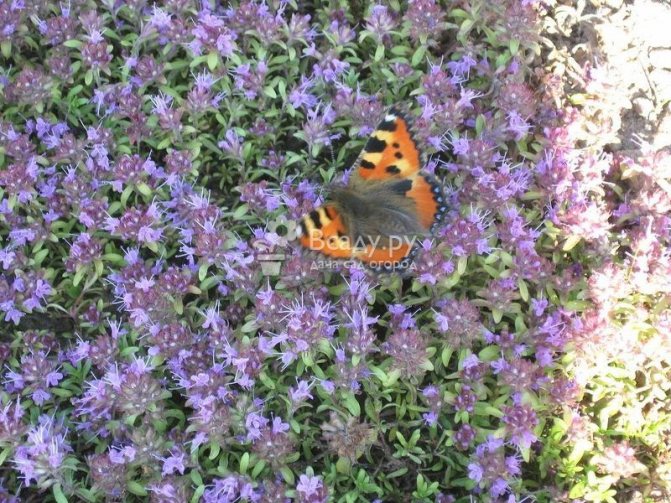

Thyme or thyme has many beneficial properties and is often used in medicine.
Thyme has many beneficial properties and uses:
- It is very effective for asthmatics. Thyme will aid in the healing of colds and flu through its diaphoretic effect. Thyme oils are recommended for insomnia and nervous system disorders;
- Tea made from thyme flowers is recommended to drink in the morning to raise the mood, it is also indispensable for migraines and depression;
- It is useful to take it for young children who suffer from anemia;
- Thyme is used for flatulence and fermentation problems in the intestines, it normalizes the digestion process;
- Thyme tincture is used for lotions for rheumatism and arthritis.
Contraindications
It is not recommended to be treated with thyme for the following problems:
- vascular atherosclerosis;
- arrhythmias;
- cardiosclerosis.
The fact is that the composition of thyme contains a substance called thymol, therefore it is contraindicated to use it in case of sick kidneys and liver. With an increased acidic environment of the stomach, thyme is also not worth using.Women should be careful when taking it during pregnancy. A very light tincture or infusion is recommended for them.
Description
This is a perennial that can be found in the forest and on the cultivated lands of Eurasia, North Africa, America. It also grows in Russia, preferring ravines, gentle slopes of the Siberian, Caucasian and Trans-Baikal forests. Cold winters do not scare him. During flowering, the thickets of thyme resemble a colorful carpet dyed purple or lavender.
It is interesting!
The most useful are the leaves located at the top of the stem.
The genus belongs to the Lamb family. It unites hundreds of species. More than 170 varieties grow in the Russian open spaces. All of them are winter-hardy perennials, low shrubs or shrubs. Their height depends on the species, there are dwarf plants that do not exceed 15 cm, and higher representatives, reaching 35 cm.
Shoots are woody, brown, of two types: recumbent, ascending. Peduncles are herbaceous, erect. Their surface is covered with a kind of pile. The arrangement of leaves on the shoot is opposite. Their color is in shades of yellow and green.
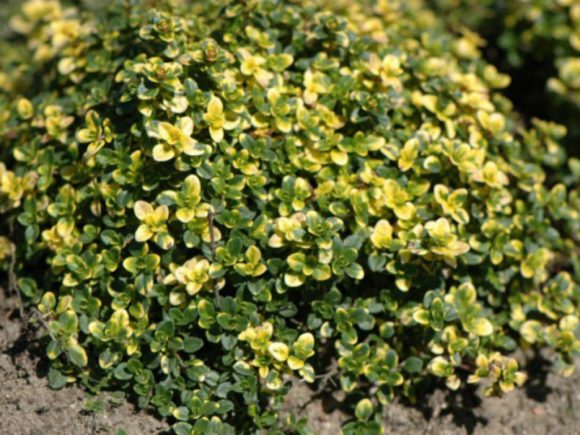

Each type is characterized by a certain shape of the sheet plate:
- lanceolate;
- rounded;
- linear-oblong.
Inflorescences are capitate or elongated, thyme seeds are black-brown, ellipsoidal, spherical. They ripen in boxes of 4 pieces each.
Answers:
He is afraid not so much of frost - it grows in the Murmansk region and in the Pamir highlands - how much dampness and heavy soil. Drops quickly also on well-fertilized soil. We have it for the 3rd year growing in a tire from a truck with a cut off upper side, filled with river sand. There is a tire in a clearing between pears. We do not cover with anything. This spring the snow has melted from above, but the earth has not yet. The water had nowhere to go and the flower bed was filled with water for a week. which at night was caught by ice.
The thyme was not damaged; over the summer, they cut it shortly three times for drying. Even more: the initially formed bald patch - out of 3 bags of seeds poured into the flowerbed, one did not ascend, - was filled with self-seeding.
But, since thyme is a very variable species, with a spread in chemical composition, aroma and color shade, it can be assumed that there are comparatively thermophilic clones.
Post date: Liuda 11 October 2014
It's time to protect the green pets from the cold. If you do this on time, they will delight you with a beautiful view and rich harvest for a long time.
Flowers
In order for roses to survive the winter better, it is necessary to stop the growth of young shoots. Let the rose bushes grow strong. A week before the shelter, it is necessary to stop watering and feeding with nitrogen fertilizers. Before warming, remove all flowers and buds, cut out dry and diseased shoots. Cut tall types of roses at a height of 20-25 cm from the ground - long shoots are more difficult to cover from frost.
Protection. Cover the soil around the bush with compost. Sprinkle the root collar (the transition zone from the root to the stem) with dry soil. Next, do the insulation. The easiest and most reliable way is to cover the roses with spruce branches. A hut from it will create a comfortable air gap between the bush and the environment. For the strength of the structure, pull the branches of the rose together with twine twine.
Perennials
Shorten the stems of herbaceous plants to 10-15 cm above the ground. Then mulch with a mixture of soil and rotted manure (2: 1). For the bulk of plants, a layer of mulch of 4-5 cm is enough. The same, in which the rhizomes grow vertically upward (primroses, heuchera, phlox), as a result of which the upper part with renewal buds bulges and becomes bare, a twice as large layer of mulch is needed. Sprinkle the mulched plants with leaves and press down on the “cover” with wire mesh or spruce branches.
Varieties of varieties
Thyme has a huge variety of varieties. It is simply amazing.Let us dwell on the main and most popular types that will best decorate your garden and will not cause hassle to care for.
Common thyme


Common thyme can be of different sizes and colors, in the photo is white thyme
It does not reach a height of more than 15 cm. It is actively used in medicine. It has small leaves, blooms in white or light purple.
There is an artificially bred hybrid based on common thyme - this is lemon thyme. It has a characteristic lemon scent.
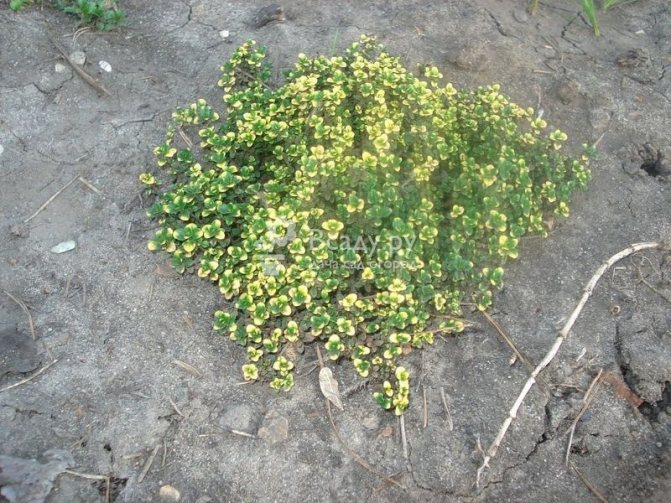

Bogorodsky color or thyme can have not only lemon aroma, but also taste
In winter, planting thyme should be covered. And to maintain the cultural form and density, the bushes need to be pruned.
Dwarf thyme
The height of the thyme is very small - up to 5 cm. This variety grows in dense islands of small diameter. Dwarf subspecies are found in white, scarlet or red.
Creeping Thyme
A perennial shrub with creeping stems. Its flowers are pink, white and crimson. The leaves are rather large and reach 1 cm in length. The flowering period falls at the end of summer.
Thyme Bogorodsky


Thyme will saturate both tea and summer air of Vsadu.Ru
Shrubs grow on one planting for up to 4 years. Their stem is thin and creeping, they are often decorated with fences, walls of houses and gazebos. This variety blooms in lilac-pink color, has a bright aroma and a bitter taste.
Thyme Rainbow
This variety is most often recommended for planting in plots, as it is very beautiful. Young leaves can be eaten and added as a seasoning to various dishes, they are very useful.
Rainbow thyme reaches 25-30 cm in height, and many summer residents plant it along the fence so that it delights them with pink and purple flowers. With proper care, it can grow up to five years.
All about thyme
Many gardeners don't know how to plant thyme. In order for the garden to be decorated with thyme, cultivation in the country takes place in several stages, and for this you need to know what kind of soil the plant loves, and how to properly prepare it.
Thyme is not a particularly demanding plant. But still, what does thyme need, how to grow it in the country? In order to get a good harvest, you must adhere to some rules for planting a plant. First of all, this is the choice of a place for planting and soil preparation:
- When choosing a location, it must be borne in mind that thyme prefers to grow in an open, sunny place. If a shadow falls on it, then the flowers become faded and dim;
- This plant does not tolerate drafts and constant winds;
- When planting thyme, it must be borne in mind that the soil must be neutral, while the groundwater must be deep.
What thyme looks like
Thyme is a herbaceous plant, a perennial. In nature, you can find small shrubs that thin out the pleasant lemon aroma - this is thyme or thyme. By the way, among the people, this undersized bush has several more names, these are “scraper” or “The Virgin's Grass”. Since ancient times, people have decorated the icon of the Virgin with sprigs of a scraper when they celebrated the day of the Dormition of the Most Holy Theotokos. This plant symbolizes goodness, luck and prosperity.
Wild thyme can be found on rocky slopes and in the steppe. Thyme grows even on sands, forest edges and small pine meadows. The shrub is hardy and unpretentious, so if you meet thyme at the edge of the forest and collect this fragrant plant during the flowering period, then next year you can come to this place again to replenish the stock of the medicinal plant.
By the way, there are up to 150 species of this plant in Russia alone, and more than 300 varieties of thyme all over the world. All these plant varieties have not been studied by breeders, so only a few species of thyme are officially registered in our country.
How do you know that there is a medicinal plant in front of you? Thyme stems reach a height of no more than 25 cm, they are branched, acquire a red-brown color. Leaves on thin stems are small, oblong, with curled edges. The plant blooms from early May to late August. The flowers are small, from pale pink to purple. Flower baskets are located on the tops.
Until a few centuries ago, thyme was widely used as a medicine, dried thyme flowers were brewed and tea was drunk to speed up the healing process from colds and get rid of coughs. Thyme is also widely used in cooking as a spice. Currently, the area of application of this plant is quite extensive: it is not only medicine and cooking, but also perfumery. In addition, breeders managed to breed several varieties of an ornamental plant, so that thyme can be grown on your backyard and made a hedge.
Nowadays, people rarely use herb as a preventive measure to strengthen immunity and improve sleep. And in vain, our grandmothers also made pillows from mint, lemon balm and thyme. And you can also check if this is so - try first to grow thyme from seeds, and then fill a small pillow with dry fragrant herb. You will see that in a few weeks you will feel energized and your sleep will improve.
Vegetative propagation of thyme
Vegetative propagation of thyme involves dividing the bush and rooting cuttings. Perform both procedures in the spring.
You can divide the bushes at intervals of 3 years. Dig up the plant, shake off the soil from the rhizomes, divide it into parts at the base, carefully untangling the roots. Each section should contain a formed root system and growth buds. Plant in planting holes that match the size of the root system. Water well. To make the delenki take root faster, provide temporary shading.
Root the cuttings in a container of damp sand. Cover the container with cuttings on top with foil or glass. Spray the soil periodically with a spray bottle. Rooting takes 15-20 days. Then plant in a permanent growth site.
Video about a useful plant thyme:
Thyme is popularly called thyme or Bogorodskaya herb. It is a perennial plant. The plant got its second name because it is used to decorate the icon of the Virgin during the celebration of the Assumption of the Virgin. This herb is found in fields, meadows, mountains. Thyme grows in the suburbs, the middle zone of the Urals. That is, he settles where there is a lot of light and heat. Thanks to them, the plant is filled with useful properties, which are subsequently shared in the prepared fragrant tea. Consider how to grow thyme planting and care in the open field, what is required for this.
Choosing a place on the site for growing thyme
The flower loves warmth and a lot of sunlight, it is preferable to plant it in well-lit, open glades. In the shade, it develops much worse, but it's okay if the flowerbed is located under the crown of openwork trees that scatter the sun's rays. These trees include rowan, sea buckthorn.
The soil should be chosen light and rich in nutrients. When preparing a flower bed, the depleted substrate on the site should be replaced with a more fertile one or humus should be added at the rate of 4 kg per 1 m². Thyme prefers soil that is neutral in composition, and even sour. To increase acidity, peat is added to the soil.
Mineral fertilizers also have a beneficial effect on the development of the plant:
- potassium salt,
- ammonium sulfate,
- superphosphate,
- ammonium nitrate.
When planting and caring for thyme, highly concentrated fertilizers are used, guided by the instructions, or complex mineral compositions are used.
Thyme properties
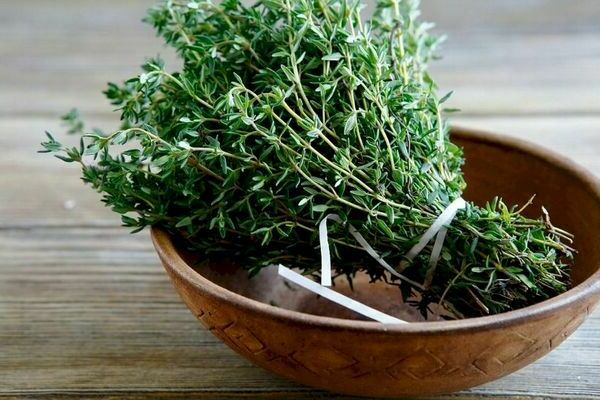

Thyme tolerates frost well enough, so there are practically no problems with this perennial plant. The only thing that can harm him very much is stagnation of water. But nevertheless, if you are worried that your plant will freeze, you can simply simply insulate it for the winter. Dry leaves, other dried herbs and peat are very good for this. And it is also best to keep an eye on in winter so that there is a lot of snow at the place where the thyme is grown.
In order to preserve thyme and use it in both cooking and medicine, you need to cut it off at the right time. This is best done in June and late August. The plant should bloom at this time, it is then that it is most useful. It is the grass that was cut on time that is appreciated. Moreover, the grass must be cut off, since it is simply impossible to pluck it due to the fact that the root system of the plant is very weak and you can pull it out completely.
In order for the thyme to dry well, it must be tied in brooms or bunches and hung in a draft. This should be done in a dry room, where the sun does not reach at all. Also, the grass can be simply laid out neatly on any surface. After the grass is completely dry, it must be crushed for further storage. Moreover, only flowers are needed, and the stems themselves are simply thrown away. The storage container must be tightly closed and also stand in a dry place. Then it will remain healthy and fragrant, and it will remain so for the next two years.
Even the most inexperienced gardener can easily grow a plant like thyme, because there is absolutely nothing complicated about it, the rules are so simple that even a child can cope. And since it is widely used in cooking, folk medicine and landscape design, and also acts as an excellent flavoring agent, every year it becomes more and more popular and grows in almost every area. And the fact that it easily adapts to any weather conditions and endures drought and frost is its huge plus. And in spite of the fact that it emerges from seeds for a very long time, it takes root amazingly quickly. With proper care, this plant will delight you with its beauty and smell throughout the season, and the rest of the time with its benefits and taste in dried form.
When does thyme bloom?
The flowering period of thyme is from June to July.
The herb thyme has many other names. The most famous is thyme (thyme), among others: chavor, chebarka, lebyushka, lemon scent, Bogorodskaya grass, boron pepper, incense, verest.
The genus unites more than 400 species that can be found in Eurasia, America and Africa. The places of growth are forest edges, steppes, pine sands, rocky areas, mountain tundra.
The fragrant grass covering the earth with a flowering carpet has long attracted human attention. The healing properties (antibacterial, antiviral, antibacterial) of thyme were written by Teofast, Avicenna, Diosconite. The Egyptians used thyme in rituals, the Greeks called the plant the breath of life. The ancient Romans considered thyme a symbol of masculinity, ranked the ability to maintain masculine strength (potency). In Slavic culture, it was believed that if you burn thyme twigs and inhale the aroma, the world of spirits and gods will open.
A blooming groundcover is so beautiful that it is grown for decorative purposes. The best place is an alpine slide.
Presowing seed preparation
To improve germination, seeds are treated with growth stimulants before sowing. For example, you can use "Epin" or "Zircon". The preparations are diluted in strict accordance with the attached annotations. The juice of ordinary homemade aloe is also good. A few drops of juice are diluted in several tablespoons of water. The seeds are soaked in the resulting mixture.
Zircon


Epin
Thyme in the home medicine cabinet
Before the advent of antibiotics, thyme oil was a powerful antiviral, antifungal, and antibacterial agent. Thyme contains coffee, cinchona, oleic, chlorogenic, ursular and oleanolic acids, fats, gums, flavonoids, vitamin C and many mineral salts. Tea and various infusions of thyme help with various diseases (cough, bronchitis, whooping cough, high blood pressure, circulatory problems), and are used as an immunity stimulator and general tonic. In addition, thyme is classified as an aphrodisiac.
In cooking, thyme is used as a spice and seasoning, but more often it is included in various spice mixtures.
If dried thyme is sewn into a bag and placed in a closet, it will reliably protect things from moths.
Thyme, he is
thyme
creeping, or "
bogorodskaya grass
". It is no coincidence that he is called so: on the day of the Holy Trinity, houses are decorated with it, and on the feast of the Dormition of the Theotokos, he can be seen as a crown to the icon of the Theotokos.
Thyme
- a storehouse of useful substances. This herb has been widely used in Russia at all times. I myself often use it as a "help" for a child with a strong cough. On me
thyme tea
acts as an anti-fatigue, soothing agent. There is something unique and special in the smell of thyme. I confess that I have been using the thyme collected in the mountains of Karachay-Cherkessia for several years now, and I have planted it only this year.
This plant belongs to to the family of luciferous... The genus of thyme (Thymus) is complex, it includes low shrubs and semi-shrubs with pronounced aromatic properties.
Thyme is the richest "storehouse" of medicinal essential oil. Its stems are stiff, recumbent or erect. Their height is about 35 cm. Flowers at the ends of the inflorescences are collected in heads or small panicles. The color is quite varied: from white to pink, purple and even yellow.
I am attracted by its small flowers as an addition to other plants. But not only flowers are decorative. Thyme has unusual leaves. They can be oblong or rounded, of various sizes, with smooth or jagged edges. It is an excellent plant for alpine slides and rockeries.
Not to be confused with thyme and savory, read more about this in the article of the same name.
We used to call thyme creeping thyme, but there are many more species and varieties that grow with us and are loved by gardeners. On the territory of our country, about 170 different types of thyme... The most popular and interesting you will find in the publication Thyme in your garden: species and varieties. It is worth planting several of them in your garden, and on a sultry evening, a wonderful smell will cheer you up.
Thyme is a fairly unpretentious plant, the main thing is to take into account the basic principles of its cultivation, and there will never be problems with it.
Thyme and its features
Blooming thyme has its own unique aroma. Its small inflorescences, added to the bouquet of wildflowers, will create a special atmosphere in the house and fill it with their enchanting scent.
Thyme is a crop, part of the lamb family. In nature, it is often found in mountainous and hilly areas, its stems are quite dense and most often curl along the ground, and the height of the shrub does not exceed 35 cm.
It often resembles grass or low shrubs, but has a unique scent. Thyme is distinguished during flowering for its beautiful purple petals. But there are different types of it. Of all kinds of colors, there are white, yellow and even scarlet shades. Small leaves of thyme are rounded or elongated with jagged edges.
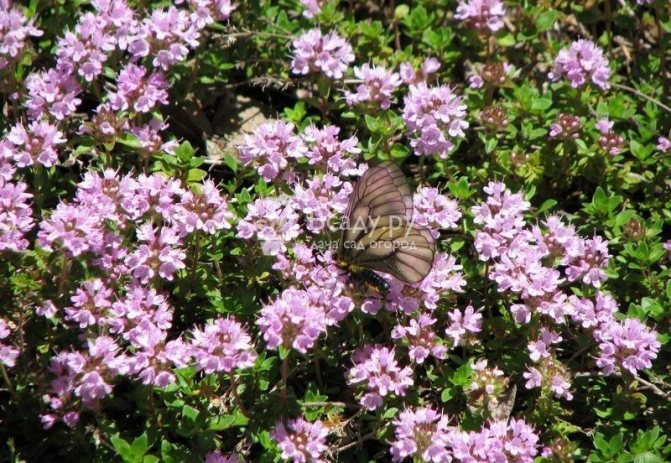

Features of thyme as a plant
Thyme has a distinctive feature: more than 100 different species can grow in a small area. Gardeners love it very much, but not only for its useful and medicinal properties.If you plant it near your house in the country or in the garden, then on a quiet evening you can relax and unwind, enjoying the pleasant aroma of these magnificent flowers. Thyme is absolutely unpretentious, you just need to adhere to the basic rules for growing and care, and then there will be no problems with it.
Thyme: planting a plant
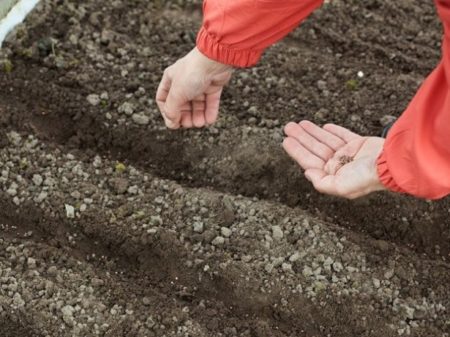

Thyme (and thyme) is a perennial plant, in one place it can successfully grow and develop for about 5-7 years. A site for planting thyme must be chosen, taking into account this nuance, as well as all important aspects of growing a fragrant shrub: choosing a suitable planting material for a gardener, choosing a place, preparing the soil, and time for reproduction.
How to choose and prepare seedlings
Experienced gardeners, deciding to grow thyme on their site, first of all, learn about the agrotechnical requirements of a new culture for them. With regard to thyme, it is safe to say that this plant will not cause many problems for gardeners. It is unpretentious in care, any novice plant breeder can handle planting and reproduction.
Seeds, green cuttings or seedlings of thyme can be purchased in specialized stores, from private entrepreneurs, and on the Internet. When buying planting material, you should pay attention to the following indicators:
- seeds must be of high quality, shelf life cannot exceed 2 years;
- green thyme cuttings are stored for about 30 days, they are sold in special sealed packages to prevent the shoots from drying out;
- young seedlings obtained by dividing the bush should have at least 5-8 root suckers, and the stems of the plant should be healthy, strong, without deformations.
Planting thyme in open ground will not take much time, it is necessary to carry out a disinfecting treatment of the planting material in a weak solution of potassium permanganate for 20-30 minutes before planting a seedling.
Interesting!
Bouquets of thyme (Bogorodskaya grass) were the main decoration of churches and temples on the Day of the Assumption of the Virgin. According to biblical tradition, Jesus was born by the Virgin Mary on a bed of thyme.
Site selection and soil preparation


Thyme, growing, over time occupies a significant territory at the summer cottage. Some gardeners like this, others not particularly, so the place chosen for growing thyme should be available for caring for it: weeding, thinning or removing overgrown bushes.
The place for planting thyme should be well lit by the sun, the plant tolerates slight shading satisfactorily, but shady areas are not for thyme. In the shade, it stretches in height, the flowering decreases noticeably, and the deciduous part, on the contrary, becomes thicker and covers the entire ground in the beds.
Thyme is not picky about the composition of the soil, but it is still preferable to plant it on neutral or slightly alkaline substrates, heavy clay and excessively moist soil inhibits plant growth, leads to decay of the root system. It is necessary in such areas to equip a drainage system to drain water.
How to plant thyme in the country: terms and rules for planting
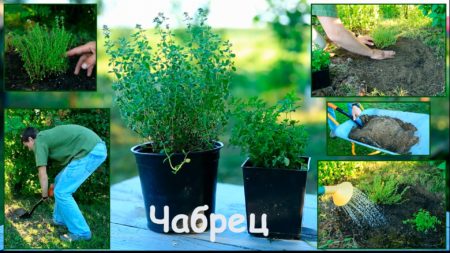

Thyme seedlings are planted in early spring or late autumn. The most suitable time for sowing is April-May. A site for planting thyme is prepared in advance, in summer - for autumn, and in autumn - for spring plantings, or 1-2 months before planting seedlings.
The holes are dug 2 times larger than the pot in which the seedlings were grown, the depth is slightly deeper (by 5-7 cm). Garden soil, light and well fertilized, is mixed with sand. Part is poured onto the bottom of the hole, a seedling is placed in the hole, and covered with the remaining substrate. The plant is watered and mulched with material at hand: sawdust, wood chips, small pebbles or crushed bark.
Interesting!
In ancient Russia, livestock was fumigated with the sweet fragrant smoke of thyme to protect them from evil spirits, and hunting and fishing tackle was used to attract good luck.
Sowing seeds and growing seedlings
The flower is planted in spring, in the market or in the gardening department, you can buy seedlings already grown in the nursery or buy seeds. Young plants grow eagerly and quickly, so it will not be difficult to grow seedlings on your own.
Sowing begins in the first half of March. For this, boxes with drainage holes are prepared and filled with a nutrient substrate. You can purchase a ready-made mixture for growing vegetable or flower seedlings. The seeds are laid out in a box, then sprinkled with a thin layer of earth and watered. For the flowers to grow successfully, it is necessary to create greenhouse conditions, therefore, the boxes should be covered with a polyethylene "cap" or transparent glass should be placed on top. Further cultivation of thyme should take place at an air temperature in the room not lower than + 20 ° C.
Further, the gardener needs to be patient, the first entrances will appear only on the 15th day, and at first they will grow slowly and reluctantly. In the 20th of May, the grown seedlings are planted on the site. Before this, it is advisable to harden the plants, taking them out for a couple of hours before planting in the open air. When decorating a flower bed, the distance between the rows should be 35 cm, and between the specimens - 20 cm.
Thyme - planting and leaving in the future will not be too difficult. If the spring is early, then sowing seeds can be done immediately in open ground. This is done from 5 to 30 March. However, in this case, the seedlings will have to wait a little longer, at least 25 days. Sowing is carried out with a continuous carpet, and as soon as the seedlings sprout, the plantings are thinned out. Over the summer, the plant will reach impressive sizes, but, unfortunately, it will bloom only next year.

